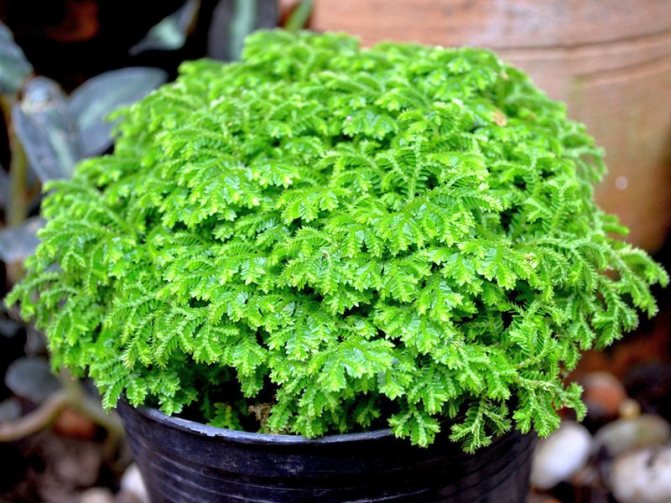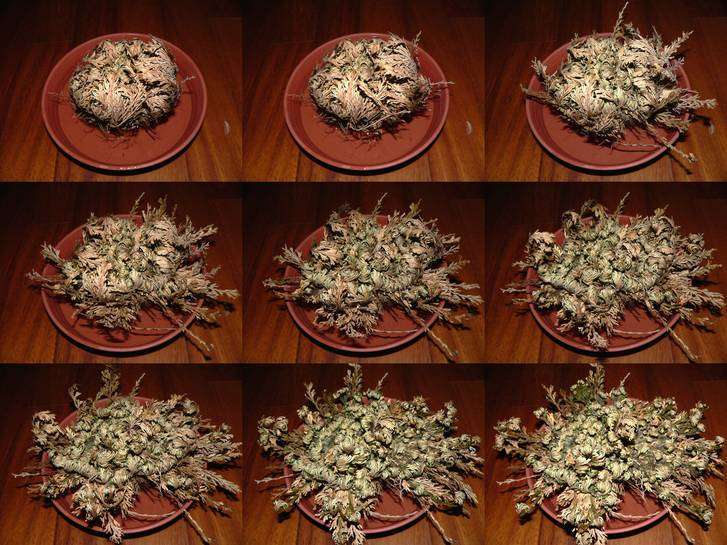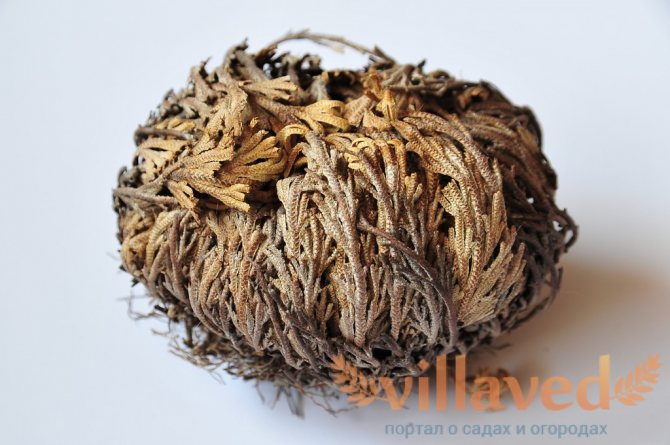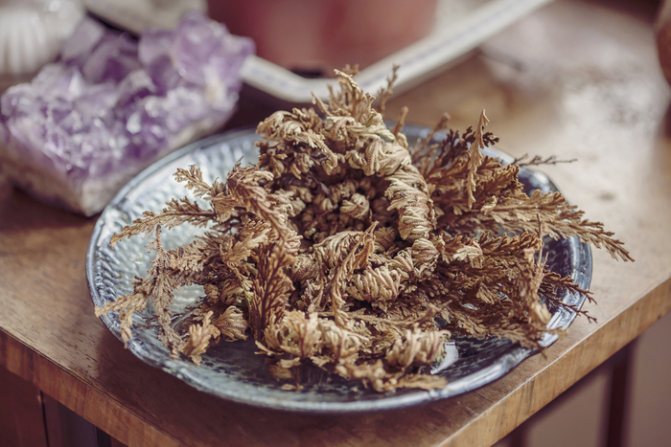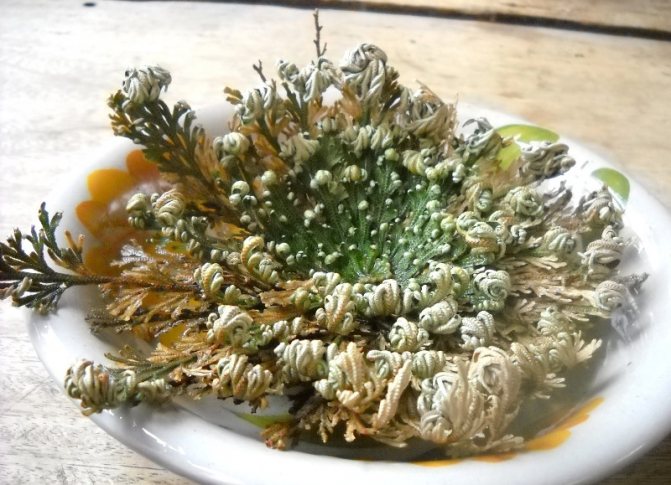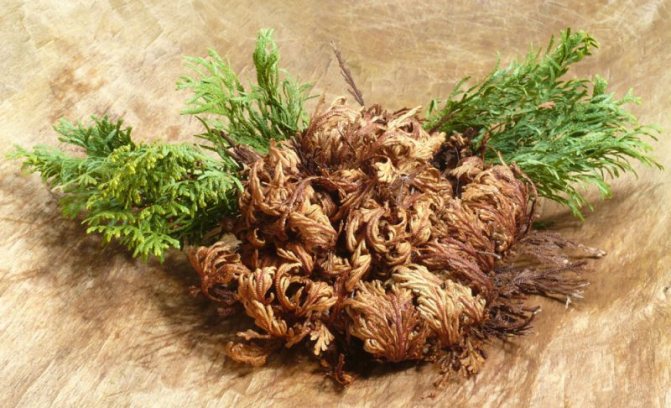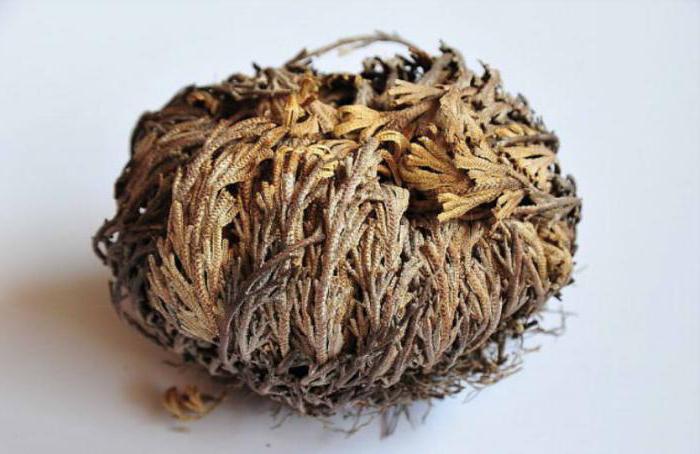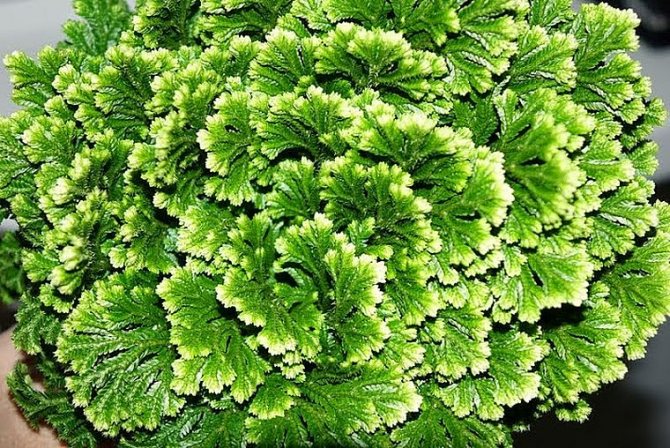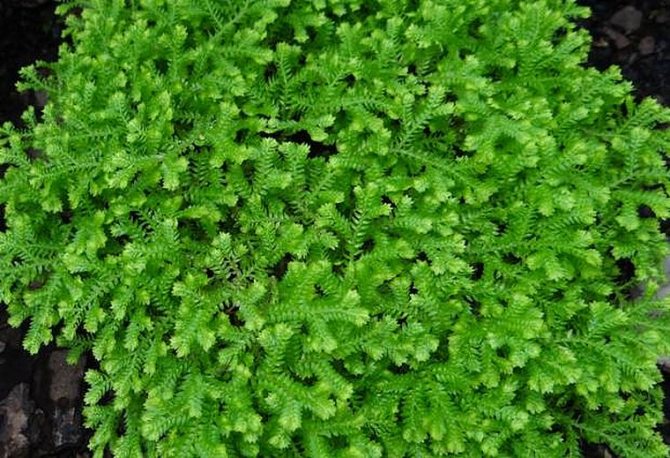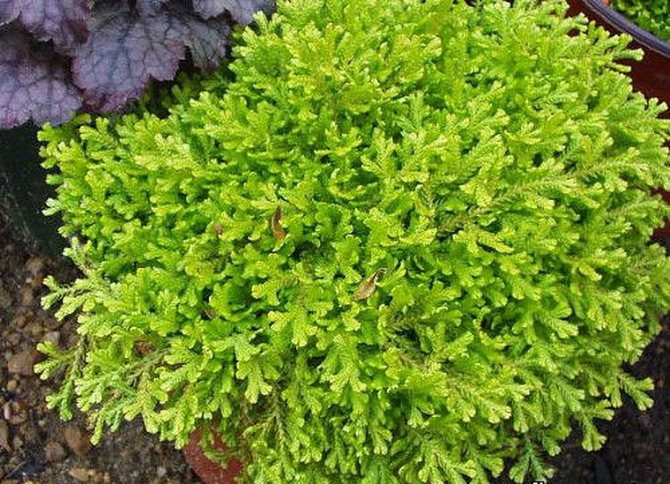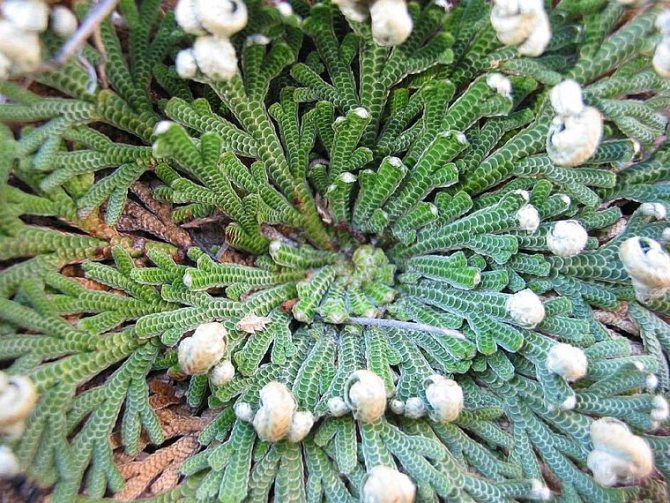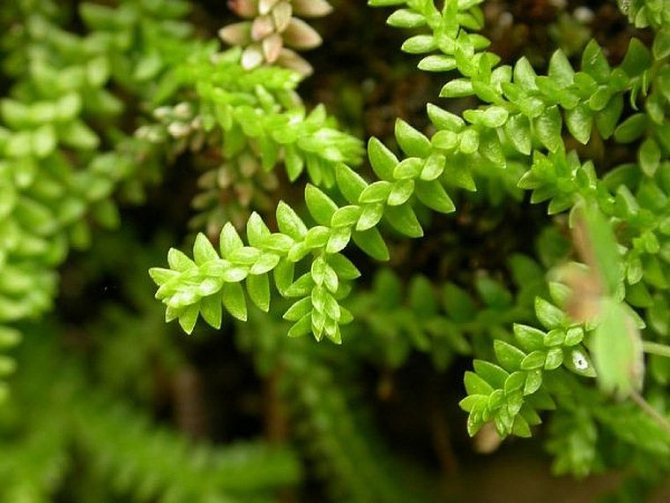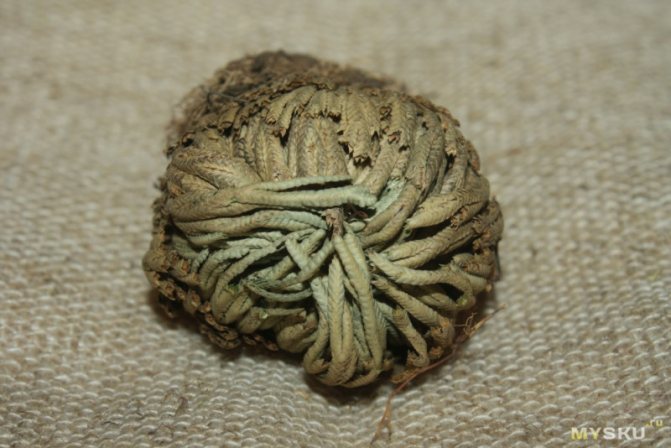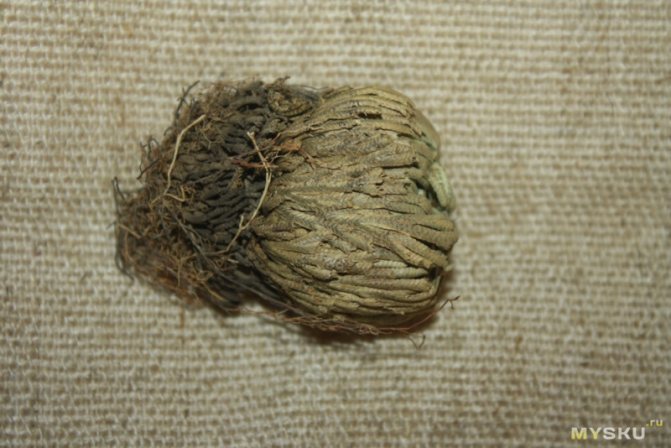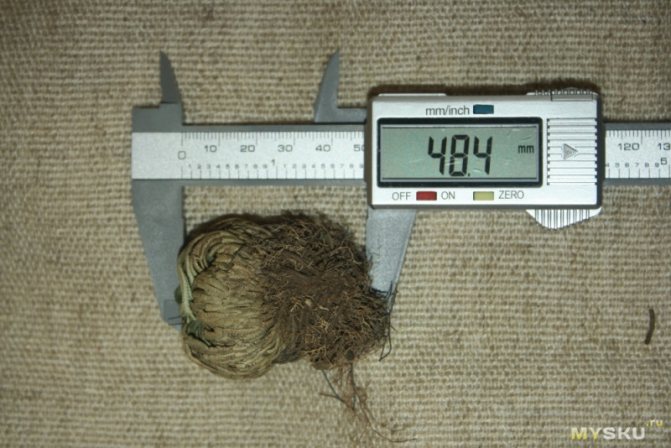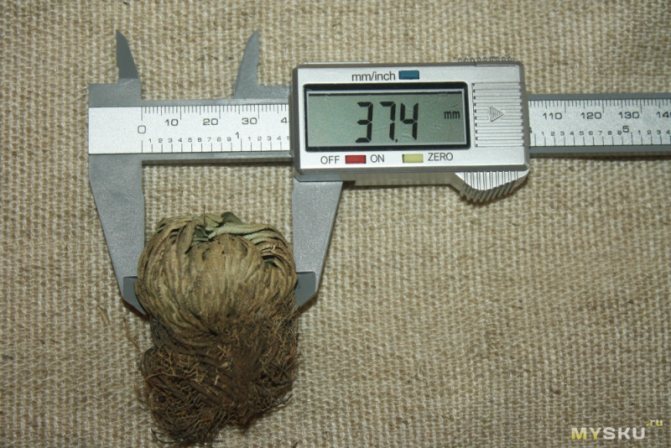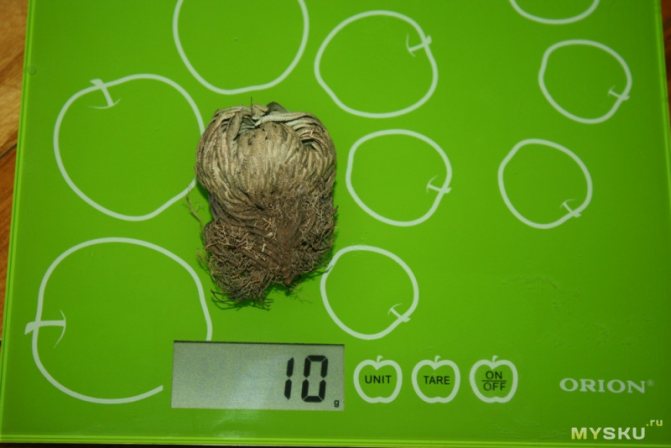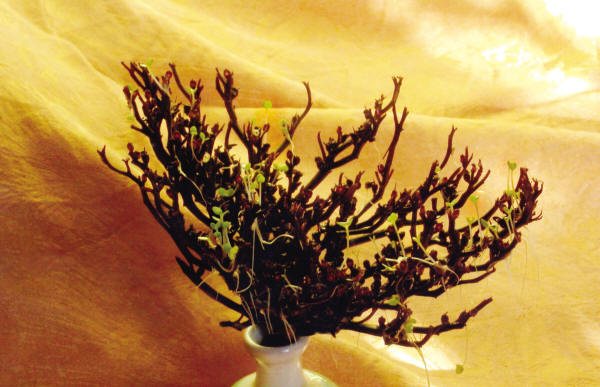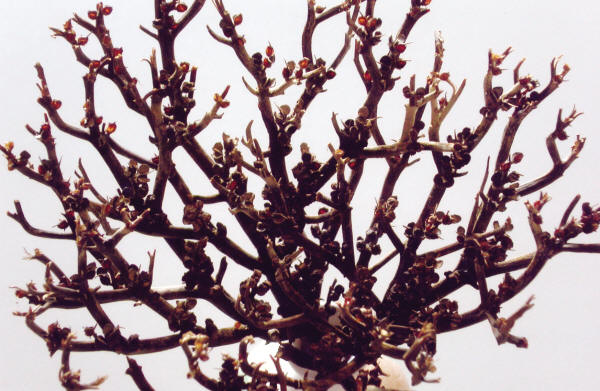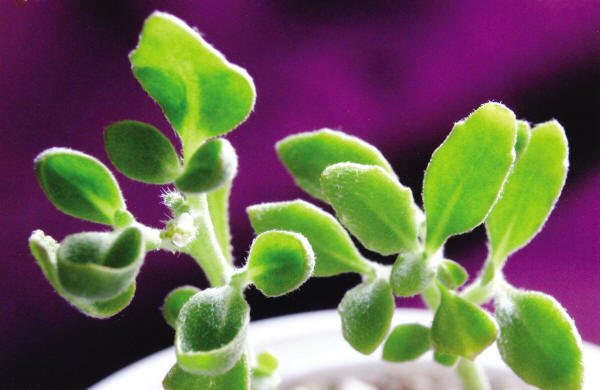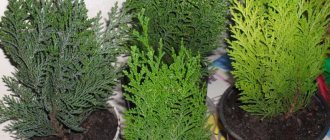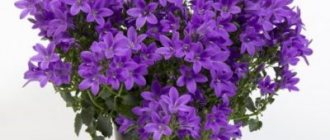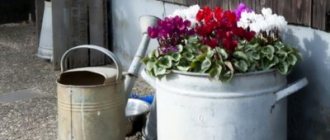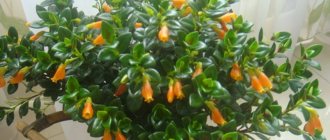The Jericho rose is native to the Middle East. Botanical name - Anastatica Jericho, it is formed from the ancient Greek words "again" and "revived". According to legend, this plant was seen by the Virgin Mary on her way to Egypt and blessed him with eternal life. Hence another name - Egyptian rose.
This herbaceous plant is capable of growing in such harsh conditions, where most plants die. How to grow a Jericho rose and how to care for it at home - further in this article.
General description of the plant
The birthplace of the Jericho rose is America, Mexico, the USA and South Africa. In fact, this is not an indoor flower - it does not tolerate low humidity well. But if you want to grow it, you should adhere to some rules. Among selaginella there are epiphytes that can live on tree trunks.
The stems are covered with small leaves, and some species resemble shingles. Such plants are relatively not tall - they do not bloom, but spread like a carpet on the ground. However, if you want to create a greenhouse, you should take into account the possibility of raising such a guest.
Description of the species
Selaginella belongs to the Selaginella family, which has more than 600 perennial species. In nature, the plant lives in areas of tropical forests and swamps, it can be in the water for a long period without sunlight, while its roots do not rot. Among the varieties of selaginella, one can also find epiphytes that grow on tree crowns, on boulders and in rocky crevices.
Outwardly, the plant is very reminiscent of moss or lycophone - it has the same small leaves and thin stems. Depending on the type, the Jericho rose has erect, creeping, ascending or creeping stems. The height of the plant depends on the conditions of the area where it grows, and can reach 20-30 cm. The leaves do not exceed 0.7 cm in length and have a varied shape. The shade can vary from dark green to light green, sometimes a small reddish pattern can be seen on the leaf.
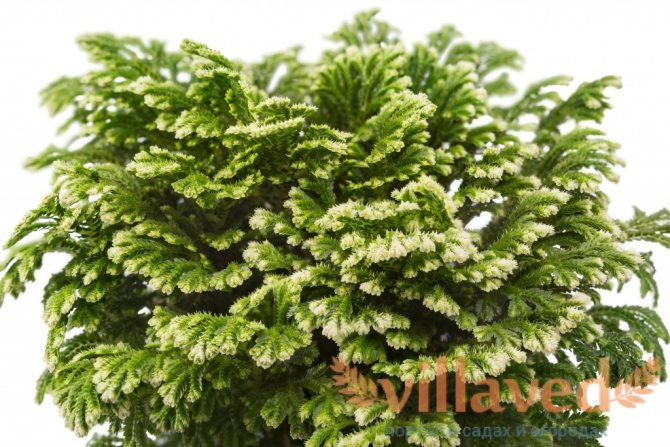
Selaginella
At home, the Jericho rose is grown as a ground cover crop, but some species can also be used as ampelous. Selaginella is not used as an aquarium plant, as it stops growing in the aquarium and soon dies.
Plant life cycle
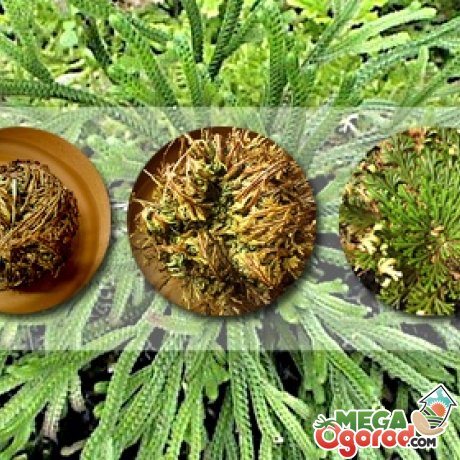

It is noteworthy that the Jericho rose is often called another plant - the Scaly-leaved Selaginella. Although the Hawaiian scrub resembles anastatica in its appearance and features of the life cycle, it would still be a mistake to consider it a Jericho rose.
What actually happens to the plant during a drought period? By the end of the growing season, the leaves of the rose fall off, and the branches die and dry up, shrinking into a dense ball, inside which the fruits are reliably preserved. The dried root breaks off, turning the Jericho rose into a tumbleweed. So the plant conquers all new habitats, waiting for periods of rains.
On favorable moist soil, dried branches open up, releasing pods into the light, which will give life to new shoots.
And, although according to legend, the rose is reborn endlessly, its life cycle in reality is still limited and is about thirty years, which is also impressive!
But it is especially surprising that in a dried form this plant can be stored for many years.
Plant feature
The life cycle of this rose is very fast. It starts growing in spring, quickly begins to bloom and set fruits. Her flowers are white, small, inconspicuous. Seeds are formed in capsule pods.
The peculiarity of this plant is that, with a lack of moisture, it gradually curls towards the center and dries up, hiding the fruits in the middle of the ball. Having turned into a tumbleweed, it begins to look for new habitats, capturing the same glomeruli along the way.
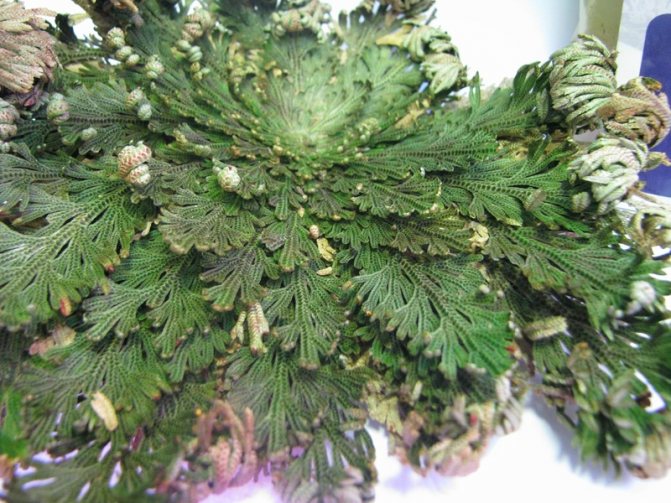

Jericho rose
This is how they move until the rain stops them. After watering, the rose comes to life, straightens, seeds spill out of it, which quickly germinate in a humid environment.
Also, during its movement across the territory, these grains fall out and germinate under favorable conditions along the entire route of its movement. Soon, the seedlings release white buds, in which the seeds are again tied, which are able to remain viable for a long time.
Important! The dried Jericho rose does not come to life, but releases seeds from the ball, which germinate. They can germinate even while in the mother plant.
It is often confused with scaly silaginella, which does not bloom and reproduces by spores. It is she who wakes up in humid conditions and goes to rest during drought. Those who have never seen how these balls look when opened may confuse them. You can distinguish them by the root system:
- the anastatic has a taproot;
- Silaginella is fibrous.
How to care for a Jericho rose?
If the flower is purchased from a store, it will look like a small, brown ball. In order for it to open, you need to pour boiled water at room temperature into a plate or a small tray and put the plant. After a couple of hours, the plant will begin to come to life. Every day, water should be added so that only the roots are in the water, and after 7-8 days the flower will fully open, and its dry leaves will revive, acquiring a beautiful and rich green color. After a week of watering, you should give the flower a rest, and therefore do not water it for 2 weeks. Then it is transplanted into a pot. If you do not water it for 7-10 days, it will begin to dry out and return back to a dry state. Most of all, children love to watch the "resurrection" of this exotic and amazing plant.
The Rose of Jericho does not like the scorching sun. She will feel great on the north window. And the south window will have to be shaded or simply removed the flower away from the window. Regular loosening of the soil will help oxygen get into the soil, thereby prolonging the flowering and growth of the plant. Spraying is done 2-3 times a day with lukewarm water. In winter, the temperature in the room with the flower should not fall below 14-120 C. In the summer, an increase of more than 200 C is not allowed, otherwise the growth of the plant may slow down.
It is recommended to feed the rose no more often than once every 4-5 weeks. It is better to use fertilizer that is suitable for any color.
This video features a home plant called the Jericho Rose.
Celaginella jory. Reproduction
Selaginella jory is very easy to reproduce. This happens with the help of rootlets or shoots that spread along the ground.
Reproduction by means of roots is carried out during plant transplantation. To do this, very carefully, without knocking the whole earth off the roots, separate a part of healthy, young roots about 5 cm long and plant them in separate pots in groups of 3-5 pieces.At the same time, the soil should be loose, slightly acidic and have sufficient drainage. It is better to propagate in this way during the transplantation of the plant, in the spring, and it is done once every two years. Cover with foil for 7-10 days and after 25-30 days the first shoots will appear.
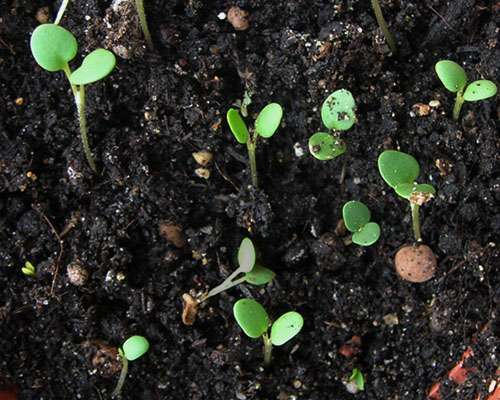

Shoots are chosen with strong and intact root-shoots. Such processes are buried on the surface in the soil of peat and sand. Next, you need to cover the flower with a plastic or plastic cap to create increased humidity. It will take about two weeks to root. The pot for this plant should not be high, but wide.
There is another way of reproduction - this is by spores. But even professional gardeners are reluctant to engage in this type of reproduction.
Laurel
| In stock. 1 plant | UAH 70 |
Also known as the "Resurrection Plant". This is a living miracle! To give a loved one a Jericho rose is tantamount to a declaration of love and an expression of gratitude simply for the fact that he exists.
Selaginella scaly, gets its name: "Resurrection Plant" because it can survive long periods of drought by rolling its branches into a brown, dry ball. However, when water appears, Selaginella easily "resurrects" and regains its bright green color. She needs about 24 hours to recover. It has been estimated that these plants could go without water for almost 100 years and will revive after soaking!
An example of a photo of a sold plant:
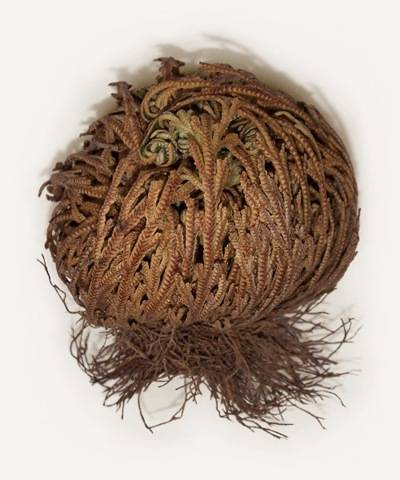

The Jericho rose is sent in a transparent zip-flat bag (bag with a fastener), in an envelope, without a box. If you need a shipping box, add it to your shopping cart.
Another name: Scaly Selaginella, Jericho Rose, Jericho Rose, Spike Moss, Dinosaur Plant, Miracle Plant, Prehistoric Plant, Siempre Viva (Live Forever), Resurrection Plant.
Scientific name: Selaginella Lepidophylla.
Climatic zones: 8-10 / Home plant.
Plant height and width: from 15 to 30 cm.
The size: from 4 to 6 cm
Description:
The Jericho rose naturally grows in North Africa, Southwest Asia, Southwest America and Central America. It is a plant from arid regions, and is often found curled up (dormant).
Care, growing the Jericho rose:
An amazing plant, just a miracle! You will get it dry and seemingly lifeless, but just soak the Jericho rose in water and before your eyes the plant comes to life, opens up, turns green and even blooms. Due to its incredible ability to revive, the Jericho rose is called the “Resurrection Plant”.
When plants have no access to water, they go into a dormant period (again turn brown balls). The dormant period is about 14 days, and then the plant is watered again and the Jericho rose is resurrected again.
Scaly Selaginella is a symbol of rebirth. She is often awakened for the holiday and put on the festive table as a decoration.
The soil: The plant does not require planting. This plant tolerates a dormant period normally, curling up into a dry ball, for a long time, without soil under it. Then, place it in a bowl of water and within a few hours, you will have a flowering plant! Of course, you can plant it, but watering during rest should be avoided. Great for a desert garden.
More about growing Selaginella scaly
Wake the plant up and take care of it for 2 weeks (watering). Then stop watering, and when the plant "falls asleep" do not water it for about 2 weeks. The plant can be dormant for 50 years.
The plant can be placed in terrariums, put into a fountain, included in desert garden compositions, or simply put in a plate of a suitable size.
It is unnecessary to use fertilizer, since this plant is a symbiosis of two organisms. It grows through their interaction. Instead of soil, small pebbles, sand, etc. are suitable. Or simply place the plant in a container of water. If the water is standing (for example, in a plate or vase), change it regularly (so that the water does not acidify).
How to wake up this sleeping beauty:


Prepare a container in which the plant will wake up.


Put in a container Selaginella scaly, fill it with water and watch how it wakes up!
It takes about 24 hours from rest to full recovery.


In nature, this plant, being in a state of deep "sleep", is able to wait for years, rare in those parts of the rain. And after the rain, its leaves quickly come to life, acquiring a green color, and the plant actively lives and reproduces for some time. But, in the absence of new rains and moisture, after some time, it again goes to rest.


It should be noted that attempts to deprive this plant of a drought period inevitably lead to its death. And with its indoor (greenhouse) cultivation, it also makes no sense to plant it in fertile soil, and even more so, to feed it with fertilizers.
These are very ancient plants that have been living on planet Earth for more than 290 million years ... The Jericho rose is almost immortal the same age as the dinosaurs.
You may also be interested in:
- AGROTECHNICS OF WHITE CABBAGE
- Kombucha (Medusomyces gisevi)
- Watering Tips
- What is transshipment?
- Plumeria, seed mix (Plumeria)
- Dionea Muscipula (Venus flytrap)
- Goji (Lycium barbarum)
- How to germinate succulents from seeds
Top dressing and transplanting
The soil should be recharged monthly. You can use nitrogenous fertilizers. Every two years (in spring), the Jericho rose requires a transplant to improve growth.
I must say that the plant is resistant to various diseases and pests. Its only enemy is dry air, which can provoke the development of a spider mite. A regular soap solution will help get rid of it.
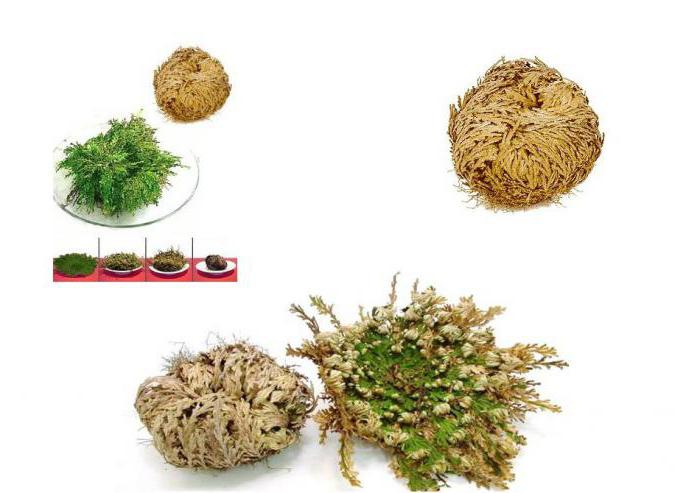

The plant is propagated by green cuttings. To do this, in early spring, plant them in a small greenhouse and put it in the shade. The cuttings will take root in two weeks.
Selaginella care rules
The Jericho rose is a rather whimsical plant and therefore you should definitely follow these recommendations.
- Temperature conditions. The most optimal temperature is 18 degrees. The plant loves warmth, but you should not exceed the established temperature regime, that is, it should not be more than 20 degrees inside the room.
- Shine. The plant does not like direct sunlight, it is better if it is light partial shade (see.
Photo). - Moderate humidity. Since the plant "came" from the tropics, it is important to recreate the humid air, as in the tropics. To do this, it is necessary to spray it with water several times a day (at least 2 times). It is important that it is not cold water, but lukewarm. It is allowed to install a pot with selaginella in a pallet with expanded clay - while maintaining is easier.
- Watering conditions. Watering this flower is also important to organize abundant, ideally do it through a pan, then the earth itself will absorb as much water as necessary. It is very important not to overdry the plant.
- The use of fertilizers. It is necessary to recharge the soil regularly every month. Ordinary nitrogenous fertilizers will do. You can use half the recommended dose, but once every two weeks, so the "usefulness" of them will be more.
- Transfer. In the spring, every two years, it is necessary to replant the plant to improve its growth.
- Protection from disease. The plant itself is quite resistant to various diseases, and pests do not like it very much, but if the air is very dry, then spider mites can begin to sharpen it, which can be got rid of using ordinary soap solution.
- You can propagate the Jericho rose with green cuttings - in early spring, plant them in a small greenhouse and put in a shaded place. Cuttings take root within 2 weeks.
Selaginella is a rather beautiful and interesting plant, and if you organize proper care for it at home, it will delight you with its beauty for many years.
Jericho rose in the aquarium
This "magic" plant will come to life in a closed or semi-open empty aquarium with a little water, just enough for the roots to touch the water. You cannot keep the rose in water for more than 6-8 days, otherwise it will start to rot. After the plant is fully opened and young leaves appear, you should give it a "respite", that is, remove the water and do not water it. After 12-14 days, you can plant the Jericho rose in a low, but rather wide pot.
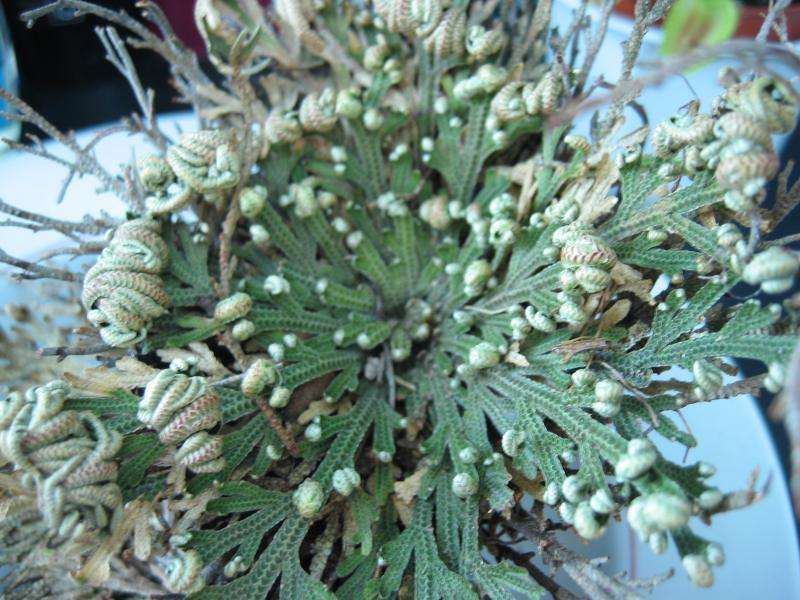

Jericho rose in the aquarium with fish
Recently, unscrupulous sellers have been selling the Jericho rose as a flower that grows in a fish tank. But this is not true. This plant should not be immersed either partially in water or completely for a long time.
Reproduction of the Jericho rose
In countries where the Jericho rose grows, it can be seen as a nondescript lump of dry thorns, moving through the sandy arid soil, thanks to the wind. Inside each such lump there are small pods with seeds that can keep themselves alive for many years.
The Jericho rose takes on the appearance of a small dried lump after the ripening of its fruits. The plant shrinks, leaving fruits inside, then breaks off the stem and sets off to travel, usually in the desert. The flower comes to life again only after it finds water on its way. The plant not only spreads its twigs, but dissolves green leaves and may even bloom.
In fact, the flower itself remains dead. And those green leaves that appeared on the straightened branches are nothing more than sprouts from seeds sprouting inside the plant.
Features of planting and caring for a rose of Jericho
Most often, the Jericho rose can be found in miniature rock gardens - rockeries. This is due to the fact that the plant does not require soil, it loves stones, sand and pebbles.
On sale you can find dry lumps called selaginella scaly.
It is enough to place a lump inside a vessel with water for the plant to begin to come to life. This process takes approximately 24 hours.
There is no need to water the dried flowers; soon it dries up again. This is a normal process for this plant.
How Selaginella scaly-leaved comes to life:
Selaginella varieties
Selaginella occurs in several species, it is important to know how they differ before determining what kind of care a particular plant needs.
The most popular and widespread type of Jericho rose is Selaginella Martens. Its stems are erect and can reach up to 30 centimeters in length, with age they become lodging. The twigs are a bit like a fern, but the tips of the leaves are silvery-white - in the photo there are luxurious specimens of this species.
No less popular is such a variety as Selaginella Belonozhkovaya. A distinctive feature of the species are short salad-colored stems.
Selaginella Scale-leaved is unique in its kind. Its stems do not exceed 10 centimeters in length, and if the humidity in the room is insufficient, then they are able to curl into a ball, but after watering, it immediately takes its previous shape, spreading the leaves.
It is for this quality of resurrection that the name Jericho rose came about. What is noteworthy, sometimes this flower can be bought dry and watch how it is revived to life at home (see photo).
Any selaginella can be grown at home, it all depends on personal preference and compliance with the following care rules.
Advantages and disadvantages
Against the backdrop of the amazing properties, there are more advantages than disadvantages.
Main advantages:
- Thanks to the age-old cycle of life, the resurrection flower can be passed on from generation to generation.
- It is customary to give a dried inflorescence as a gift on the occasion of the Resurrection of the Lord. The flower acts as a kind of reminder of being.
- Lovers give each other an inflorescence by placing a ring inside. You can get it when the flower opens.
- It does not require watering for many months, which is very convenient for those who forget to do it.
- Dry air, heat, wind cannot harm the flower. It is very unpretentious.
- If you store a rose inside a cabinet, its properties allow you to ward off moths.
Among the disadvantages, it should be noted that it will not grow without drought. Under normal conditions, it will die in the soil.
It is much easier to keep it at rest. Periodically awakening the inflorescence, you can enjoy this mysterious phenomenon.
For garden cultivation, it is better to use varieties specially cultivated for this purpose.
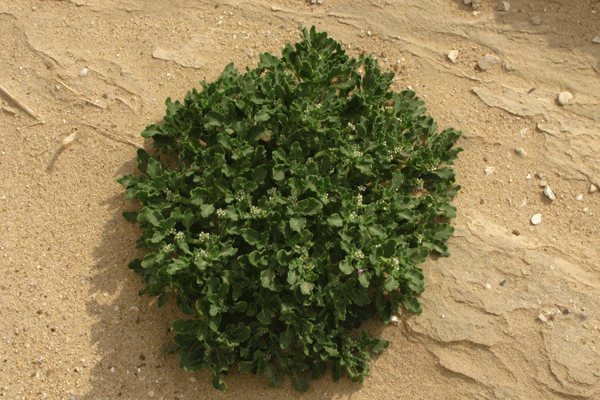

For garden cultivation, it is better to use varieties specially cultivated for this purpose.
Description and life cycle of the Jericho rose
Outwardly, the flower bears no resemblance to the garden queens of the garden. The flower was first discovered in the Middle Ages. Although it was mentioned much earlier.
On the pages of the Bible, it is called "the hand of Mary." This name is given with good reason. When the flower dries up, it curls up like a hand into a fist. In this position, the inflorescence can spend several months.
A dried lump travels through the desert in a gust of wind. Like a tumbleweed nailed to the water. The beauty of Jericho revives from moisture. Therefore, it is often called the "resurrected" flower.
The plant is distributed mainly in Western Asia and North Africa. The life cycle is up to 100 years, during which you can watch his death and resurrection every time.
The plant adheres tightly to the soil. Due to its miniature size, other plants simply clutter it up.
We mainly use it for landscaping premises, aquariums and places near the reservoir. And only some varieties of the Jericho beauty can be grown in flower beds.
The plant is distributed mainly in Western Asia and North Africa.
Selaginella flower propagation
It is possible to propagate Selaginella during transplantation, by dividing the roots. And those species that form creeping shoots can take root on their own.
Selaginella Krauss and Martens propagate by cuttings at high humidity. They take root very easily, due to the fact that the plant constantly forms air roots on the shoots.
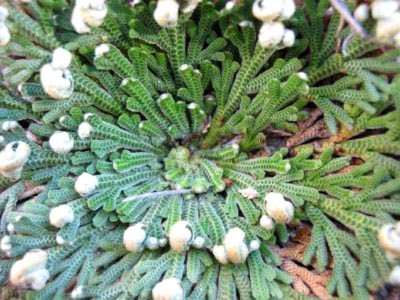

What is this flower, description
Hearing such an unusual name, many are wondering: what is it - the Jericho rose? In its natural environment, the plant grows in western Asia and North Africa, in the form of tumbleweeds. According to the Russian writer and poet A.I. Bunin, who wrote the story "The Rose of Jericho" after traveling to the East, the life cycle of an exotic plant is 50 years.


In nature, the growing season of small bushes up to 15 cm high begins in early spring, while there is a supply of moisture in the desert areas. The growing period is very compressed: the plant blooms quickly and forms fruit after a short period of time.
With the onset of the dry period, the stems twist inward, forming a ball, which, under the influence of the wind, breaks off and rolls across the open spaces. Over time, due to the meeting of such tumbleweeds with each other, a large lump is formed, which, upon reaching moisture, blooms like a wondrous flower, pouring out rapidly sprouting seeds.
On a note. Despite the fact that the shoots of the Jericho rose bloom, one should not trust the stories that they come to life, giving new greenery.
Views
There are such plant varieties:
- Martensi.
- Jory or Yori.
- Hook.
- Legless.
- Kraus.
- Emmel.
- Scaly.
Selaginella Martens
The plant has in its composition erect branched shoots, the height of which is 30 cm. In their shape, they have many similarities with a fern. The color of the leaves is bright green with golden sporangia.
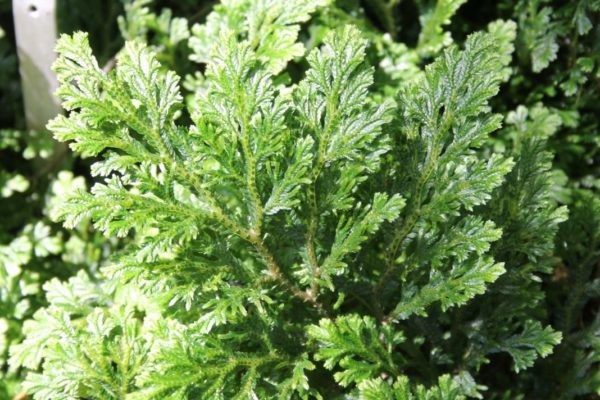

Jory or Yori
This type of plant is small in size. The laconic bushes have straight shoots, which are characterized by a light green color with a golden edging.
This type is especially popular because it is decorative and is characterized by blotches of white. Different varieties of roses are available for sale.
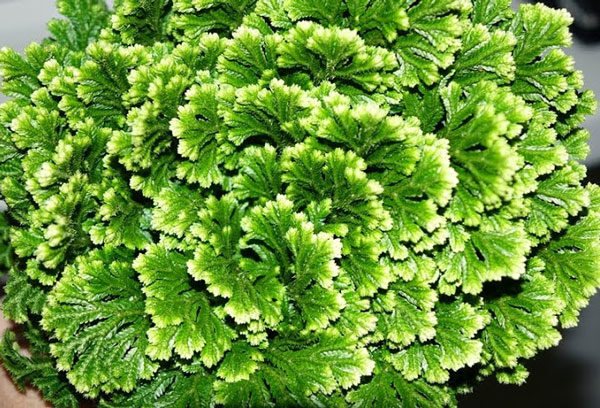

Hook
This variety is a representative of the genus, which attracts flower growers with its unusual color of the leaves. According to scientists, this shade is not pigmentation. They are confident that a blue tint is obtained when shading. Despite the fact that it may be the cause of this color, the hooked rose of Jericho is still popular with many gardeners.
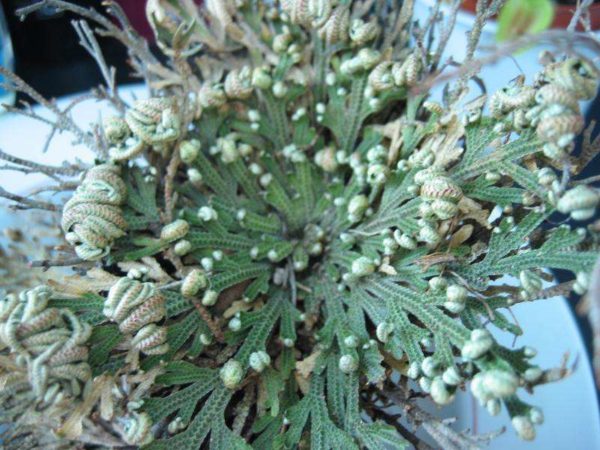

Legless
A legless plant is considered to be undersized. Its leaves are yellowish with a heart-like base. Indoor legless selaginella is found in hanging pots as an ampelous plant. Its homeland is North America, where the plant survives severe winters under a layer of snow.
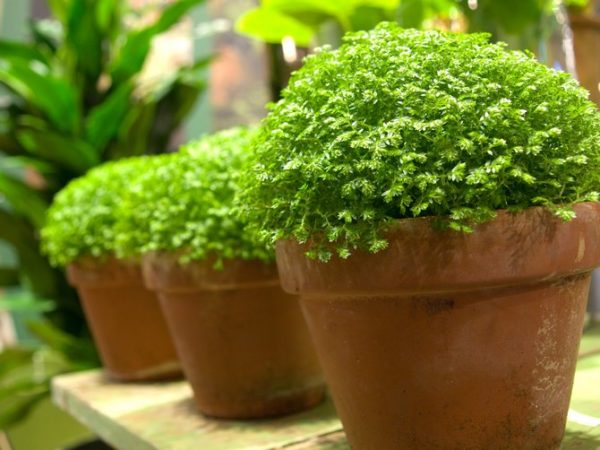

Kraus
Selaginella Krausa or golden variety is a plant presented as an original bush, 30 cm high. It has bright green leaves. This rose comes from South America, and it grows mainly in deciduous forests.
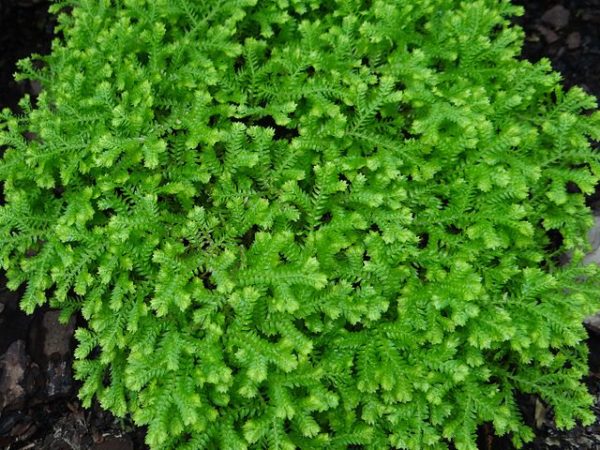

Emmel
The plant is found in the wild in Ecuador. It prefers diffused light, so it is better to plant it on western and eastern windows.
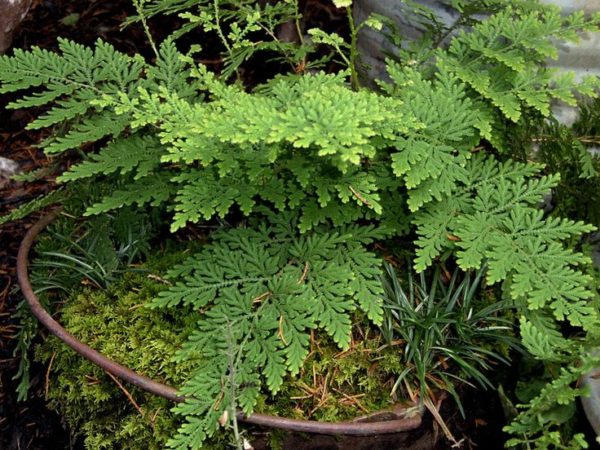

Scale-leaved
Selaginella scaly is very original and unique. She is a relative of the fern plant that has lived on the earth for many years.
Selaginella varieties
Selaginella occurs in several species, it is important to know how they differ before determining what kind of care a particular plant needs.
The most popular and widespread type of Jericho rose is Selaginella Martens. Its stems are erect and can reach up to 30 centimeters in length, with age they become lodging. The twigs are a bit like a fern, but the tips of the leaves are silvery-white - in the photo there are luxurious specimens of this species.
No less popular is such a variety as Selaginella Belonozhkovaya. A distinctive feature of the species are short salad-colored stems.
Selaginella Scale-leaved is unique in its kind. Its stems do not exceed 10 centimeters in length, and if the humidity in the room is insufficient, then they are able to curl into a ball, but after watering, it immediately takes its previous shape, spreading the leaves.
It is for this quality of resurrection that the name Jericho rose came about. What is noteworthy, sometimes this flower can be bought dry and watch how it is revived to life at home (see photo).
Any selaginella can be grown at home, it all depends on personal preference and compliance with the following care rules.
Selaginella home care
The selaginella plant loves bright, diffused light, but does not tolerate direct sunlight. It is better to place it on the windows of the east or west orientation, although it feels good also near the windows of the north exposure. If the plant is placed near south-facing windows, you should provide diffused bright light by covering the windows with paper or a translucent cloth. The plant tolerates shady places normally.
For not particularly demanding species, when grown in summer, room temperature is enough, and in winter they feel good at temperatures from 14 to 17 degrees, they can tolerate a short-term drop in temperature to 12 degrees.At low temperatures, Selaginella Kraussa and legless are fine. Species that are thermophilic plants need to provide a temperature regime above 20 degrees throughout the year.
The selaginella plant must be provided with year-round abundant watering, as the top layer of the soil dries up. Do not allow the earthen coma to dry out, the soil should be constantly moderately moist. It is best to water through the pallet so that the soil itself absorbs the necessary moisture. In this case, only soft, settled water at room temperature is used.
It is also necessary to provide the plant with increased air humidity, the minimum humidity is considered to be 60 percent. But at the same time, do not forget that the higher the humidity in the room, the better this room should be ventilated. To increase the humidity, the pot with the plant is best placed on a pallet with damp pebbles, expanded clay, peat or sphagnum moss.
The selaginella plant is fertilized once a month in the spring-autumn period, with a diluted fertilizer, approximately 1 to 3, and also once a month and a half in the autumn-winter period, only 1 to 4 with diluted fertilizer. , before feeding the plant, to ensure air access.
In the spring-autumn period, overgrown plants are transplanted once every 2 years. At the same time, it is recommended to select dishes that are not high, due to the fact that Selaginella has a shallow root system. The soil is made up of equal parts of sod and peat land with the addition of chopped parts of sphagnum moss, or you can take ready-made slightly acidic soil with a pH of 5-6. Do not forget to lay good drainage for the plant.
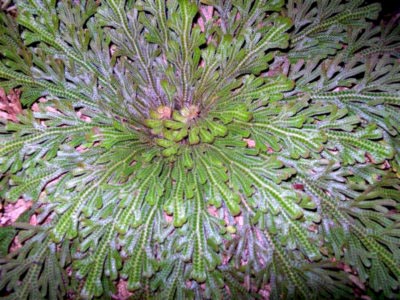

Selaginella care rules
The Jericho rose is a rather whimsical plant and therefore you should definitely follow these recommendations.
- Temperature conditions. The most optimal temperature is 18 degrees. The plant loves warmth, but you should not exceed the established temperature regime, that is, it should not be more than 20 degrees inside the room.
- Shine. The plant does not like direct sunlight, it is better if it is light partial shade (see photo).
- Moderate humidity. Since the plant "came" from the tropics, it is important to recreate the humid air, as in the tropics. To do this, it is necessary to spray it with water several times a day (at least 2 times). It is important that it is not cold water, but lukewarm. It is allowed to install a pot with selaginella in a pallet with expanded clay - while maintaining is easier.
- Watering conditions. Watering this flower is also important to organize abundant, ideally do it through a pan, then the earth itself will absorb as much water as necessary.
Care after purchase
How to care for Selaginella? This flower will appeal only to experienced florists who like to grow plants in difficult conditions.
The main challenge is to create a comfortable humidity regime. Without proper care, it is impossible to grow such a culture.
However, in addition to humidity, it does not need any difficult conditions and does not have requirements for temperature conditions.
Pruning
The Jericho rose must be pruned when the plant grows old and loses its beauty. In this case, more than half of the shoots must be removed. As a result, shoots will begin to grow from the dormant buds. You can also allow the plant to be pruned to give it a round shape.
Watering
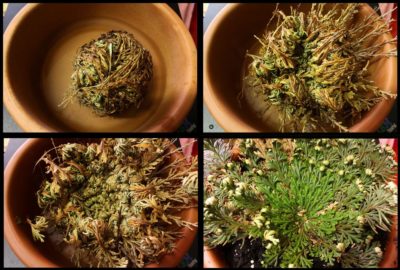

In nature, Selaginella can grow under normal conditions or in waterlogged soil. It does an excellent job of being completely submerged in water. The plant loves moisture and does not tolerate dampness or drying out.
It is not so easy to choose the optimal humidity regime. To ensure the best maintenance for the plant, you need to take advantage of the properties of the root, dense system.Classic irrigations can be replaced with automatic ones, since this way the rose will independently choose the best degree of humidity for itself.
It is important to select water for irrigation. You can use a soft one that has been allowed to stand for about three days.
Landing
Selaginella should be planted in the form of a dry brown ball. In this state, it can be transported, especially during periods of drought. For planting, you need to put the ball in water and in a day the plant will fully open.
Transfer
The attitude of the rose to transplants is negative, so it is better to do this at least once every 2 years. The right time for this is spring. Determining the need for a plant to transplant is very easy - you need to determine how full the pot is with roots. If it is completely full, it can be transplanted.
Ancient scum, or selaginella. Home care: watering, reproduction, transplantation.
Growing seeds at home
Small glass pots are suitable for growing seeds. You can also use a terrarium or tropical bottle. Do not forget about high-quality drainage.
Normal growth can be observed in water-consuming soil.
The basis of the substrate in which the seeds are planted includes sod and peat.
Reproduction
Reproduction is carried out by spores or vegetatively, by dividing the bush. In the spring, when transplanting, the rhizomes are separated and planted in peat pots. The soil must be soaked and kept moist.
Temperature
Many selaginella species need a room temperature of 18-20 degrees. She does not tolerate drafts quite well.
Lighting
Selaginella loves diffused light without the presence of sunlight. She also needs light shade and artificial light.
Growing
Rose Prince Jardinier
At home, Anastatica does not feel very well, especially in winter, when the radiators dry up the air greatly. She needs to provide high humidity. For this, a pot with a plant is placed in a pallet filled with expanded clay, pebbles, sphagnum moss. The fillers are constantly moistened with water.
A good option would be to keep it in the florarium. In these conditions, the humidity will constantly be maintained at the desired level for the bush, which is difficult to ensure in an open container.
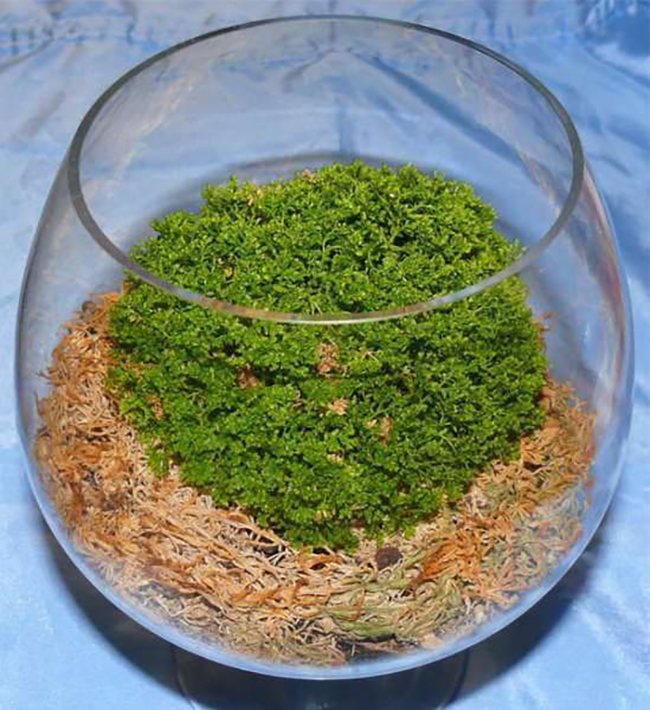

Rose of Jericho in the florarium
The rose of Jericho is a shade-tolerant plant, so it will feel good on the windowsill of the northern window. When grown on the south side of a house or apartment, the windows are slightly shaded.
Anastatica comes from an arid climate, in open areas it can grow only in the deserts of Asia and Africa. Climatic conditions with alternating winter and summer, dry air do not allow growing it in temperate latitudes.
Note! In flower shops, under the guise of a Jericho rose, they often sell scaly silaginella. It is she who, reviving, releases new shoots: she does not multiply by seeds, since she does not have them.
Jericho rose varieties and the legends surrounding it
The most famous and widespread varieties of the Jericho rose are: Anastastika Jericho and Asteriscus dwarf. Both species with a rose known to gardeners and florists are united only by the name. They come from completely different species and genera. Look further at the photo for examples of similar varieties:
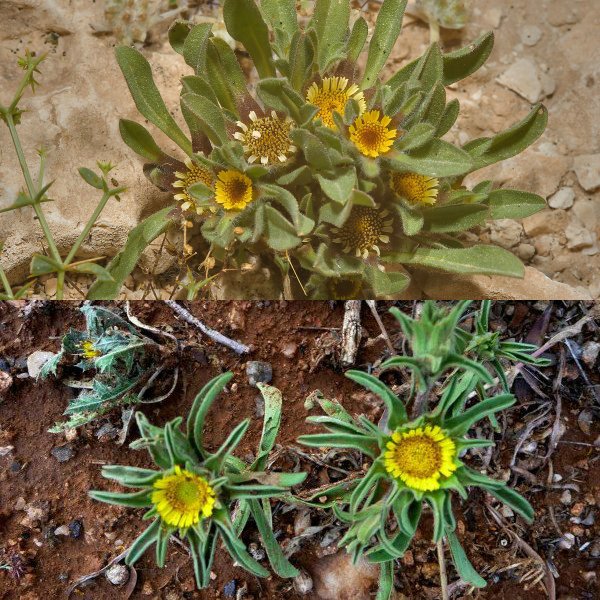

The legends and folk traditions surrounding her are interesting. Many stories have formed around the plant about its miraculous properties. Most of them, unfortunately, are rumors and lies. The plant does not cure any diseases and is not a miracle cure. The water from under the plant also has no medicinal properties. The tales of the rejuvenating properties of water are one big tale. The only feature is the fact that the plant cleans the air from pollution and cigarette smoke. This feature is found in many potted flowers. The Rose of Jericho is a very interesting plant.It gives special pleasure to children who can observe its development. This plant is a great and original gift that recipients can enjoy for months and even years. Last but not least, enjoy an accelerated video of the blooming process of this amazing plant.
Rose of Jericho
| Excursions in Israel with a personal guide Petrovskaya Svetlana Book a private tour of Israel for you and your loved ones - an individual route, affordable prices and a cozy atmosphere! Mail Mob. +972 52 6177995 ICQ: 458-540 Skype: isragid |
My services • Services of a professional guide in Israel with a license from the Ministry of Tourism by car / on foot • Carrying out one-day VIP excursions in Israel, affordable prices and good reviews from tourists • Transfer from Ben Gurion airport to any hotel in Israel individually or in a mini-group • Private jet tours
over Israel from Tel Aviv - 200 $ / 30 minutes (2-3 people) • Private excursions from cruise ships from the port of Haifa or Ashdod in Russian • Car rental in Israel, booking hotels in Tel Aviv and Jerusalem , maps of the Old City • Providing limousines and minibuses for escorting 24 hours a day throughout Israel • Shop tours (Tel Aviv), wine tours (the best wines of Israel), gourmet tours (national cuisine) • Wedding in Israel, wedding in Jerusalem, baptism on Jordan, photographer / videography
Useful links »An interactive assistant will help you book excursions around Israel in automatic mode! »Svetlana Petrovskaya: walking routes in the Old City of Jerusalem for 4/8 hours! »VIDEO-catalog of guides - a useful site where you can choose a guide for an excursion in Israel!
This type of rose grows in the Israeli deserts, located between Jerusalem and the Dead Sea, which is the lowest point on our planet. This amazing plant was first discovered by the crusaders in the Middle Ages. The crusaders noticed the unique property of the plant to "revive to life" even when its entire appearance spoke of its death. The crusaders decided to take with them several copies of the rose with them to Europe, and upon returning home they blessed the rose and christened it "The Flower of the Resurrection."
In the Bible, the rose of Jericho is mentioned in connection with the mother of Jesus Christ, Mary. Legend says that on the way to Egypt, Mary noticed this amazing plant and blessed it to live forever.
Now there is a custom, rooted in the past, to let the Jericho rose bloom at Easter and Christmas in order to surprise young children with this amazing sight. It is worth noting that the "Resurrection Flower" in the dried state does not rot! If you put a rose in a container of water, then after half an hour the flower will bloom. And if you decide to dry the plant again, then it will curl up in front of your eyes into a small ball. Many families practice the glorious custom of passing the Jericho rose from generation to generation, by inheritance, from parent to child. This custom allows you to maintain an eternal connection between generations. "Where Rose lives, bless this house."
In its natural element, the flower grows in the sand. The plant is very close to the ground, not every animal is able to detect a rose. In the summer, the seeds begin to ripen at the plant, and at this time the rose tightly closes its stems, protecting the seeds from the attack of birds. In the next rainy season, when the seeds have accumulated enough moisture for independent life, the flower begins to bloom and gives the seeds freedom.
This amazing process can take place in your room. When a rose is in a vase of water, it begins to bloom, and when there is no moisture, the flower folds. The life cycle of a plant is about 30 years. The Rose of Jericho is a wonderful and unusual gift for a special occasion in the life of your family, relatives and friends.Note that this is a gift that your children, grandchildren and great-grandchildren can enjoy in the future, as the rose actually lives forever. It is worth remembering the fact that the rose of Jericho also has healing properties. For example, a decoction of the plant is excellent for asthma, syrup from ground rose seeds increases a woman's ability to bear children.
Plant application
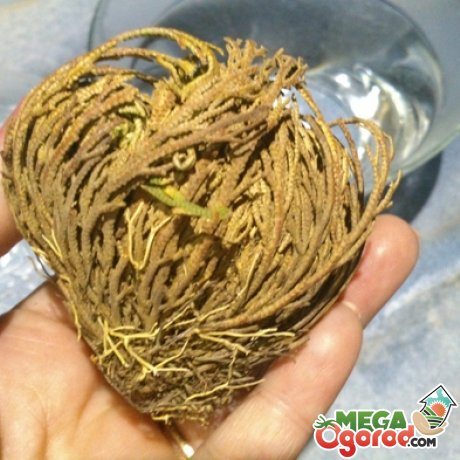

Due to the unusual property of the Jericho rose, a tradition arose:
- Passing the dried ball from generation to generation as a symbol of a blessed home that does not interrupt its lineage.
- Another custom is the tradition of resurrecting a flower for the holidays of Christmas and Easter.
- In Christianity, the Jericho rose is considered a symbol of the Resurrection of Christ. The plant blossomed on Christmas Day, died on the day of the Crucifixion and was revived again on Easter.
- Using the rose as an example, young children were told and explained the miracle of Eternal life and Resurrection.
- In ancient times, the Jericho rose was credited with miraculous properties in the fight against infertility. It was believed that a decoction from the leaves of the plant can help with asthmatic diseases.
The plant really has many beneficial properties:
- The room serves as a humidifier.
- It is a natural freshener, exuding tart, oriental-style saturated aromas of steppe herbs and desert in the room.
- Destroys harmful bacteria and disinfects the air naturally.
- Capable of absorbing tobacco smoke.
- The scent of the plant prevents allergic attacks.
- In the bedroom, it helps to create a sound and pleasant sleep.
- When dried, it destroys harmful insects. For example, a mole in the closet.
Indoor roses
Roses are suitable for growing in a room:
Repaired - bloom twice a year;
Tea-hybrid - differ in a variety of colors;
Polyanthus - profusely blooming, with a pleasant aroma, undemanding flowers;
Pernetsian - decorative, bloom until late autumn.
These should be bushes growing on their own roots, grafted onto a rosehip stalk in indoor plants, it is difficult to keep.
We bought a bush in a store and brought it home, do not rush to transplant, put it on a light windowsill, free from other flowers. Let the first time stand in splendid isolation, in quarantine, so as not to become infected with diseases and pests. In addition, a lonely flowering plant looks good and attracts attention.
History of origin and appearance
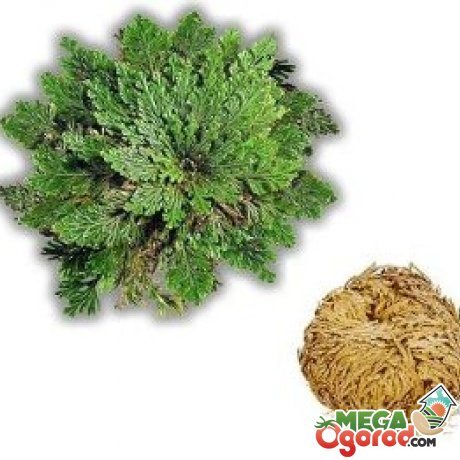

The scientific name of the Jericho rose is anastatica of Jericho (Latin Anastatica hierochuntica). It comes from the ancient Greek words "revived again" or "resurrected." For the first time, the plant was discovered in the Middle Ages by the knights - crusaders, who noticed the amazing ability to revive the flower. Returning from the campaign, they illuminated the found unusual treasure and gave it the name "Flower of the Resurrection".
According to the biblical version, the plant was discovered by Mary on the way to Egypt, giving him a blessing to immortality. Therefore, it is also called “The Hand of Mary”.
Another legend, which Ivan Bunin describes in his story "The Rose of Jericho", says that the herbaceous plant got its name from the Monk Sava, when he settled in the Judean wilderness.
The Jericho rose grows where most other botanical species are unable to survive.
Distribution area:
- Western Asia (Saudi Arabia, Qatar, Syria, Israel, Jordan, Iran).
- North Africa (Morocco, Algeria, Egypt).
Despite its name, the flowers of the plant bear little resemblance to the classic rose.
During the flowering period, the gray leaves are adorned with miniature white flower petals, which later turn into seed pods.
Due to its small size (about 15 centimeters) and tight adhesion to the soil, the rose is practically inaccessible to animals.
Silaginella scaly
Rose Ingrid Bergman
Since the store sometimes sells the scaly silaginella under the name Jericho rose.
On sale, it is exhibited in the same way as the rolled anastatic.When placed in a humid environment, the silaginella opens up, the leaves gradually turn green, with a beautiful emerald hue. It can be grown in soil, with the addition of sand, sphagnum moss and peat.
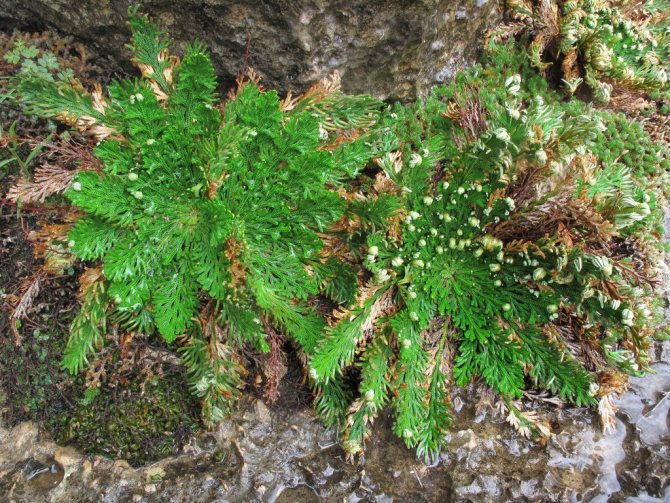

Silaginella scaly
In nature, it grows up to 10 cm in height, even less at home. Its diameter is about 40 cm. Silaginella has delicate leaves, giving it a fluffy appearance. It has this appearance during the rainy season, in hot weather the branches fold into a ball.
Note! The process of resurrection of a flower from a dry lump into a luxurious plant occurs within a day.
Silaginella reproduces by dividing the bush, cuttings, spores. Seed propagation is impossible because it has no seeds. It grows quickly, multiplies easily. The shoots contain cell sap, which keeps the bush alive even after drying out. It is rich in oils and vitamins.
Benefit and harm
For many years, Selaginella has been used by Indians and Chinese as a remedy for liver diseases. It has also been used as a cleansing agent.
Indian medicine assumed the use of roses for problems with the menstrual cycle, as well as for the treatment of jaundice, diseases of the genitourinary system. It is also useful in the treatment of cancer.
The plant contains components that interfere with the mutagenesis process. In the process of testing, the possibility of inhibiting and developing cancer was proven.
The plant has no harmful properties.
Site selection and soil preparation
Jericho roses go on sale in the form of woven lumps formed by dried shoots.
To observe the amazing "resurrection" of a flower, you must:
- choose a shaded place in the room, away from sunlight and heating appliances;
- place the "ball" in a bowl, where a little water is collected (no more than 2 cm), and after 24 hours, when the exotic has blossomed, move it into a container with sand with the addition of a small amount of pebbles.
This plant does not need fertilizers and any feeding, which is its undoubted advantage.
Important! The rose should only be placed in warm water.
Diseases and pests


The largest pest is the spider mite, the appearance of which can be observed when the air is too hot and dry. Other troubles may be the reason for not the best care of the plant. Its leaves may have a brown color, which also indicates insufficient moisture.
Folding of leaves is observed when a flowerpot with a flower stands in a draft. With a large elongation of the stems, additional lighting is needed.
Care errors and problems
| Problem and cause | How to fix |
| Drying of the ends of leaves and shoots due to lack of moisture. | Watering is required. For additional moisture, the ground part is sprayed separately. |
| Blanching of leaves and elongation of shoots with a lack of lighting. | Apply additional lighting in the form of lamps. |
| The sluggish state of the flower, the appearance of mold due to excessive watering. | The soil needs drainage as it is stagnant. And also it is necessary to reduce the number of watering. |
| Stopping growth. There is not enough fertilizer or the root system has grown, the pot has become small. | Regularly feed with complex organic and mineral fertilizers. Transplant. |
| The appearance of brown spots on the leaves, lack of water. | Regular abundant watering. |
Growing problems
The plant must be dried for at least 14 days, after which it can be awakened again.
- you can store the Jericho rose during the rest period inside any cabinet;
- it is a mistake to believe that a dried flower will be green again; after resurrection, it sprouts new shoots.
Preparing for winter
The Jericho flower has no special requirements for wintering. It is enough to dry it and place it in a warm dry place.
[collapse]
Growing recommendations
Growing the Rose of Jericho is not time consuming and very interesting.True, the slightest violation of the rules - and the plant becomes capricious. This herb is sold in the form of dried balls. It should be noted that in the end the rose does not come to life, but begins to sprout new shoots. To see how the flower will open, you should take warm water into a shallow container and dip a ball into it. Literally immediately, it will begin to gradually open up.
Water should be added every day so that the base of the plant is always in the water. If a mold bloom appears on the leaves, it means that the rose is sick with a fungus and should be treated with a weak solution of "Fungicide".
MYTHOLOGY
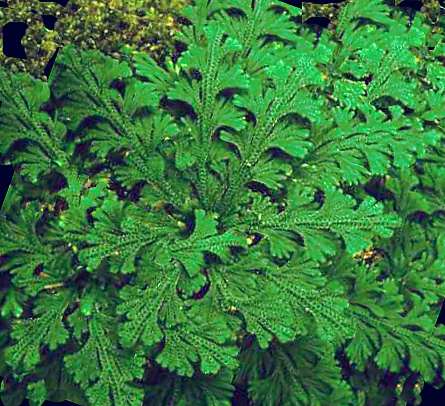

At the queen of flowers roses there is a namesake by name - Jericho rose, however, this plant is famous not for its beautiful fragrant flowers, but for its amazing vitality, thanks to which it received the name "Flower of Resurrection". Several species of annual desert plants are known under the name Jericho rose, the dried branches of which form balls that break off from the root and roll in the wind (Tumbleweed).
The plant's scientific name is Anastatica hierochuntica (Greek anastasis means resurrection) and is often found in deserts and semi-deserts. In North Africa and on the Red Sea coast, it is found everywhere. In summer, its branches bend inward around the ripe seeds and dry out to form balls. Torn off and blown away by the wind, they can be stored in this state for years, but when raindrops fall on them, the twigs, consisting of hygroscopic tissue, straighten. At the same time, the plant itself does not return to life, but seeds spill out of its fruits and fall into moist soil, giving life to new shoots. And the straightened branches seem to come to life - they straighten, turn green, but as soon as the moisture dries up, they shrink back into a dry ball.
This amazing plant was brought to Europe by the knights-crusaders. Here, anastatica was first described by the Venetian Benedetto Rinio in an illustrated book on herbs and called "the rose of the Virgin Mary". Only later they began to call it the Jericho rose. This plant has been considered a symbol of the resurrection since ancient times. During the excavations carried out by the French archaeologist Gaie in the necropolis of Antinous on the right bank of the Nile, the mummy of the Greek hetera Thais was found, in whose hand a bunch of anastatic branches was clutched.
According to legend, Mary, on her way to Egypt, noticed this amazing plant and blessed it with eternal life. The plant's amazing ability to "resurrect" was used in the holidays of Christmas and Easter. A dry plant, placed in water, blooms in half an hour, after a few hours it turns green and resembles a rose flower in shape. This plant, brought to Russia from Palestine, was credited with miraculous properties (for example, helping with childbirth).
Among the plant-predictors, the Jericho rose enjoyed the greatest fame. An old popular saying says: if the Jericho rose has opened, it will rain. Although this name is claimed by a number of plants that are not even closely related to each other, but at present it is most often applied to a plant with the Latin name Selaginella lepidophylla, which has nothing to do with Jericho or the rose. It is a soft-stemmed plant belonging to the Lycopods division and native to Mexico, Texas, and California. It can withstand drought for a long time, and when it receives water, it sucks it in like a sponge. At the same time, its curled stems unfold, and the plant comes back to life.
Used materials:
- F. Voynich, E. Herceg. One swallow does not make spring ...
Selaginella scaly
Many distributors of flower products pass this plant off as the Jericho rose. They are very similar, but they are completely different plants. If Celaginella was sold to you as the Rose of Jericho, then you should talk a little about this plant.To begin with, you need loose soil to grow a flower. A mixture of leafy earth, peat and sand in equal quantities is suitable, which should be constantly loosened. It will be good if you add fertilizer for orchids to this mixture.
Pour the prepared soil mixture into a wide, but low container with holes for drainage. It will be great if you take clay pots. Before filling it with earth, we spread a drainage layer from the pebbles to the bottom. Planting a flower can be carried out both by spores and by dividing the bush, but it is better and easier in the second way. Let's make a reservation right away that Selaginella's root system is very delicate, so we plant it very carefully.
Planting usually begins in the spring. Separate sprouts about 5 cm long from the overgrown bush, preferably with shoots. We plant sprouts in 5 pieces per pot. Water the soil in the pots well and cover the pots with foil with holes for ventilation for a week. Selaginella does not like direct sunlight, so seedling pots should be placed on the penumbra, but not in the shade. And you should also carefully monitor the temperature regime so that the temperature does not drop below +12 degrees.
It is necessary to carefully monitor the behavior of the leaves, according to them you can determine the problem that has arisen with the flower:
- Leaves are limp and soft... This means that you overdid it with watering and the roots do not have enough air. Watering should be temporarily stopped and the soil in the pot should be loosened well;
- The leaves are pale and too elongated... It follows from this that the plant does not have enough lighting and too hard water is used when watering;
- Leaves die off... Very high ambient temperature and insufficient air humidity;
- Folding leaves... The flower is affected by strong drafts and, perhaps, it requires feeding.
As you can see, Selaginella is also a capricious plant, but with good care it becomes a beautiful ornamental plant.
fikus.
Deceived hopes
In Russia you can usually find selaginella scaly (Selaginella lepidophylla) can be frustrating for many people. Moreover, the final effect does not really match the assurances of the sellers and the incredible advertising photos.
Alertness should be caused, first of all, by assurances that watering the plant with hot water will not harm, on the contrary, it will accelerate the development of leaves.
There are few living things (mainly organisms called extremophiles) that can withstand extreme temperatures. Watering with water (especially hot), selaginella will mechanically straighten its outlet, but it will not turn green, will not take root in the ground. It is pointless to wait for new green leaves and roots, they have long been dead.
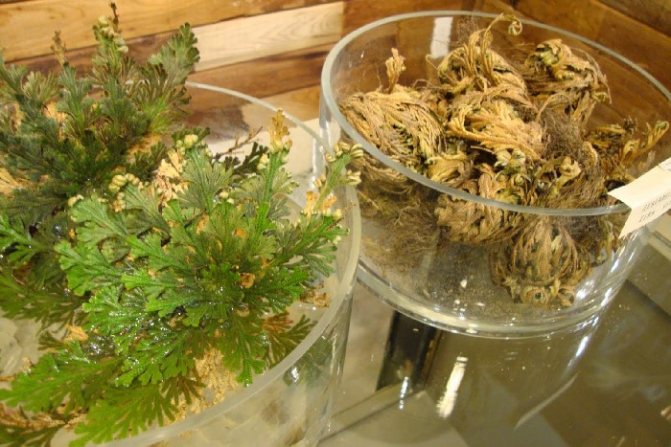

Even if kept in cold water for a long time, the plant is more likely to be covered with mold than juicy greens. You can "play" the original game with an interesting plant from the world, putting a wrinkled ball on a stand with water, it will open mechanically and inside it will be slightly green (the outer shell remains brown), after which, deprived of water, will again twist into a ball. It will definitely be a great event for children, wanting to show interesting mechanisms that take place in nature.
There is some likelihood of obtaining a lush green plant, if it is possible to acquire a living specimen, it can restore the form of life, as in nature. In this case, cultivation should be carried out in conditions of high air humidity and an appropriately selected container (glass jar).
Beneficial features
Rose of Jericho humidifies the air in the room, serves as a natural freshener, as it exudes the aroma of steppe herbs. The plant has bactericidal properties, disinfects the air. It also absorbs tobacco smoke. If placed in the bedroom, it will promote better sleep. When dried, the annual can be used to control moths in the closet.
The rose of Jericho is a very interesting and spectacular plant. With proper care, it will delight you with its exotic beauty.
Dinosaur flower. Scaly clownfish (aka Jericho rose)
The huge ancestors of the hero of the review inhabited the Earth, when dinosaurs were not even in the plans, and today their shredded descendants are popular as ornamental plants and are smartly sold on Aliexpress. In the review, a favorite of gardeners, an extreme plant, a billionaire, a playboy, a philanthropist - Scaly clown. As I wrote above, the department of lycopods has a long history - the first representatives arose in the Devonian period, and reached prosperity in the Carboniferous period. It was an amazing world - the land was inhabited mainly by amphibians and huge insects. In the absence of real trees, they were cosplayed by tree ferns and moss.


Fungi and bacteria have not yet learned how to efficiently process lignin (a compound contained in plant cells and giving them strength), therefore, dead plants did not completely decompose and eventually turned into coal, thanks to which humanity in the 18th century was able to accelerate its technological progress, appeared steam engines, electricity, calculating machines, and today, 400 million years later, we have the opportunity to order almost anything from the cunning Chinese, including the hero of today's review. Today lycopods number about a thousand species, among which there is not a single tree species. Many species are used as ornamental plants, and one, the scaly scaly, has an interesting feature - the plant can be in a “dormant mode” for several years in the form of a dried ball, and then, once it gets into the water, it revives and grows further in a few hours what has never happened. Because of this feature, the scaly scaly is often confused with another desert plant that has the same properties - the Jericho rose, which, although it can also revive after hibernation, is actually a relative of cabbage. Sellers on Ali also do not hesitate to indicate the name of the plant precisely the Jericho rose in lots with plunks. Our wife is fond of plants in our family, and the cake was ordered for her, but the thing turned out to be interesting, so I decided to tell you. I ordered two pieces at once. The package arrived in the most ordinary postal package, which made no sense to photograph. The seller of the type put another plant as a gift. I'll tell you about the minus right away. If you want to be guaranteed to get a living plant, order several copies at once. Out of three plants, our “gift” turned out to be completely dead, another specimen was half dead - there were almost no roots, and after opening, only the middle of the plant turned out to be alive. For the review, I took the most decent copy. So, we get a dry lump of light brown color with a slight tint of light green. The dimensions of dried flowers are almost 5 cm in height and slightly more than 3.5 cm in diameter, weight - 10 grams. The curled leaves form almost a ball, from below which hangs a beard of dried roots.
If you look very closely, there is something predatory in the form of these dry leaves, reminiscent of the era when everyone tried to eat everyone else and at the same time desperately evolved.
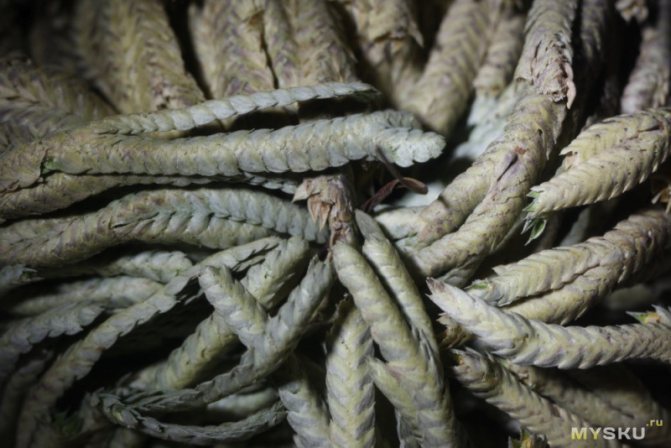

I drop the dried flower into a cup of water and time it.
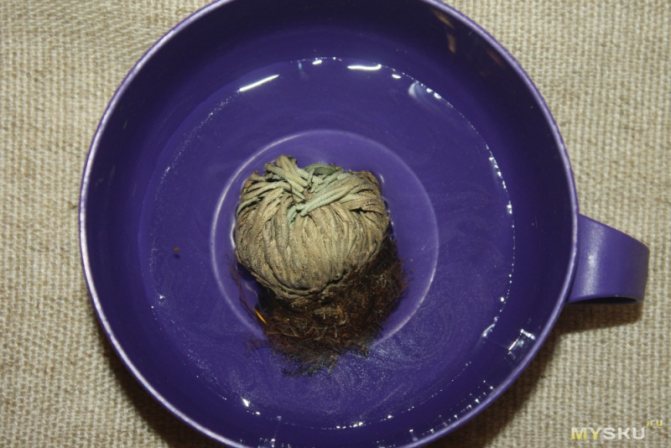

An hour later, progress is already noticeable.
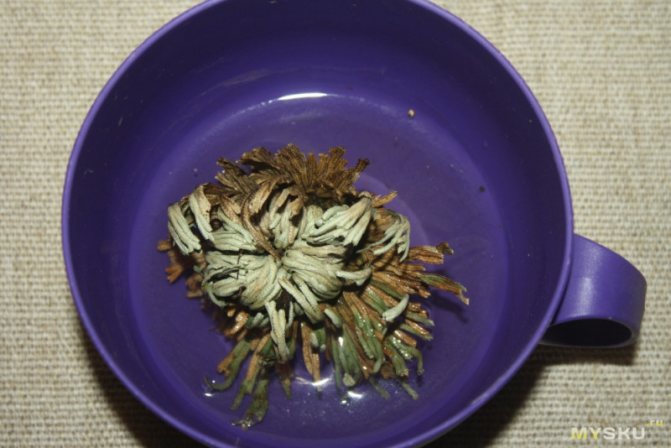

Then I photographed the process of resuscitation for the next 7 hours at intervals of an hour, and then went to bed, since it was already dead of night. In order not to stretch the review, I combined the pictures into animation.
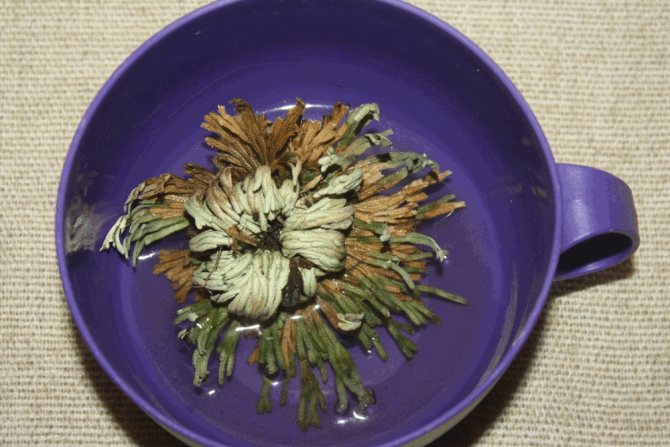

The next morning, after another 7 hours, the plant fully revived and blossomed.
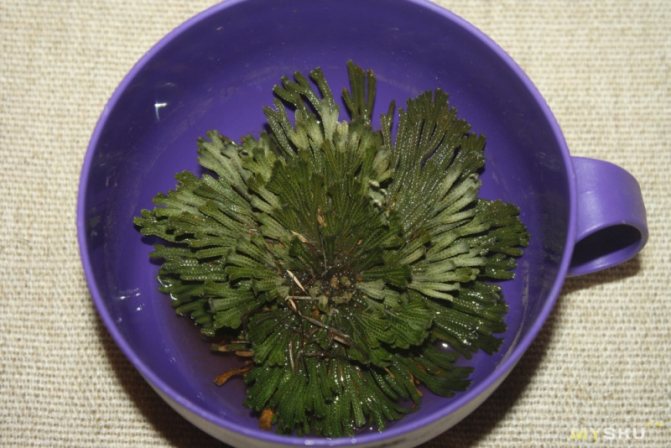

The fact that yesterday it was a herbarium is reminded only by a small “skirt” of dead leaves from below - these are those that did not survive “hibernation”.
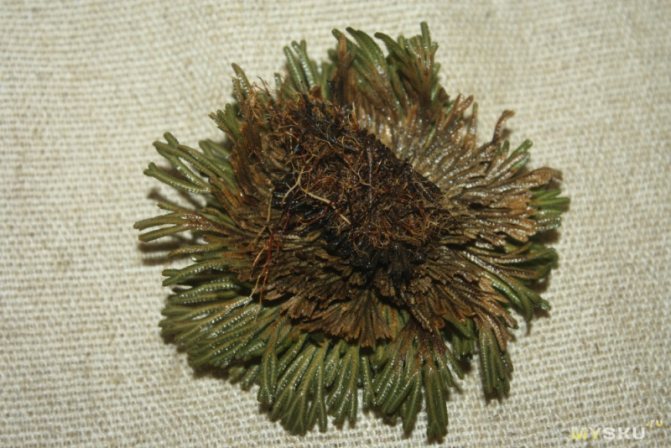

Close-up of the revived leaves look unusual and pretty.
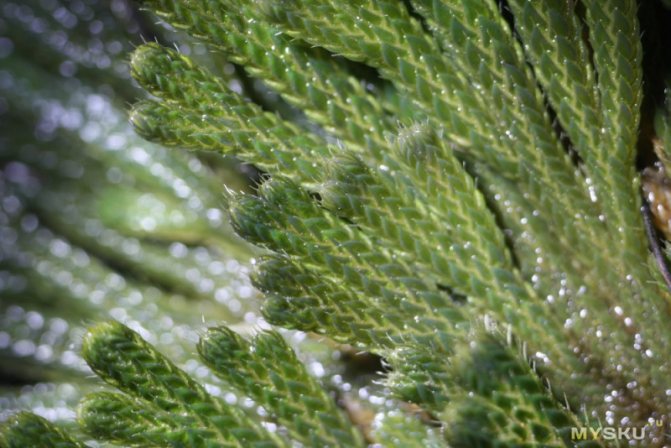

In principle, further, it was possible to plant the stem in a flowerpot and let it grow further.But I was wondering how long it would take to dry, so I pulled it out of the water and put it on the windowsill. The reverse transformation took two and a half days.
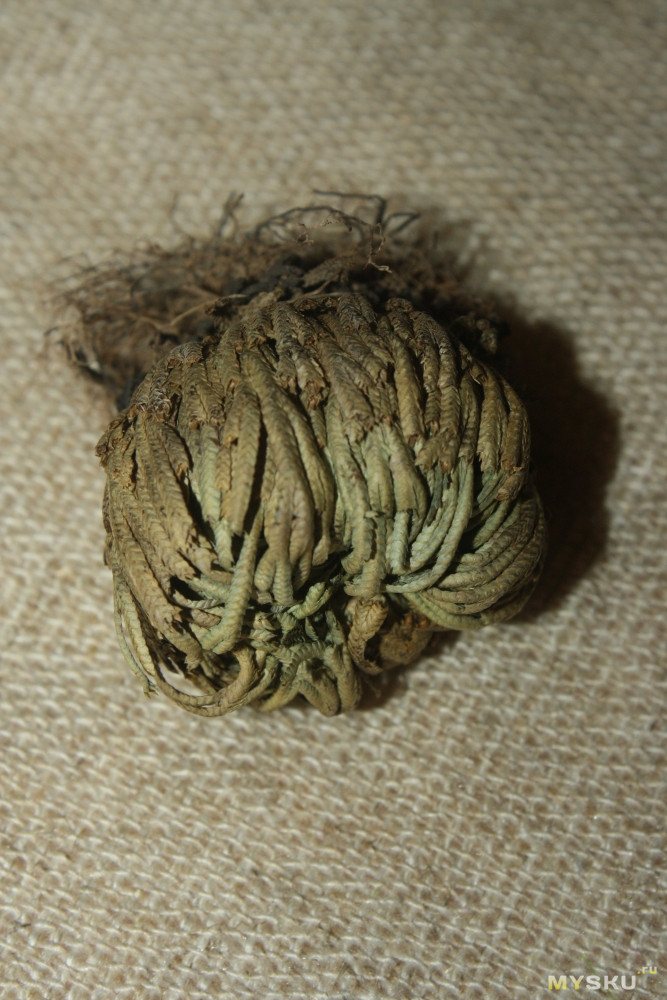

Actually, I have nothing more to say on the topic. The thing is interesting, my wife and I liked it. Perfect as a small present for a lover of any flora, or for a child as an expansion of horizons. Unfortunately, there is a risk of getting a corpse instead of a dormant living plant.
The most popular varieties of roses for growing at home
Rose Hawaiian or Argirea sinewy
Before purchasing a plant and deciding on the most optimal care methods, each grower needs to know how the popular varieties of this rose differ from each other.
Salaginella scaly
The plant can survive prolonged droughts. Upon contact with moisture, it will restore its green color. To do this, he needs about 24 hours. There is a version that scaly salaginella could survive for about 100 years without water and subsequently revive after soaking.
The plant at home can be grown in soil with the addition of peat, sand and sphagnum moss.
Asteriscus dwarf
An annual herb. After flowering, an achene is formed, which lasts for 10 months. It opens only when exposed to moisture. This usually happens in the spring.
The varieties of the Jericho rose are considered fake. Despite the fact that they are also able to survive and develop further at zero humidity.
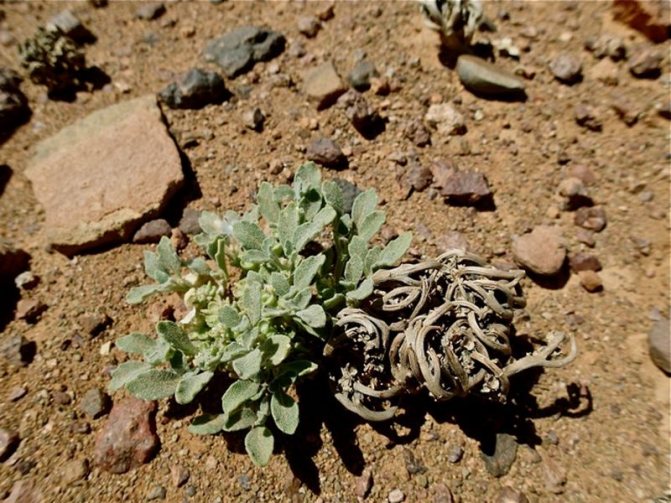

Jericho rose in the desert
Varieties of the rose of Jericho
There are many varieties of this plant. Selaginella is a low-growing bushes with many root outgrowths. It takes root quickly on surfaces with minimal soil. The most famous are the following varieties of Selaginella:
- The legless variety most often comes across in the wild. In appearance, it resembles bryophyte lumps. It is used for landscaping in the form of an ampelous plant.
- Martens has a light green color and grows up to 30 cm.
- Vildenovi is an oval bushy terrestrial plant. Feels great at home.
Children enjoy watching the resurrection of a flower. It is believed that after a dormant period, its twigs and leaves turn green again. But it's not right. Since the plant, finding itself in a favorable environment, releases new green shoots.
The Jericho rose has won the hearts of many gardeners. Its main advantage is ease of maintenance.
Rose - the flower of the Virgin


The rose was loved, worshiped, sung from time immemorial. At the same time, from the very first centuries of Christianity, the queen of flowers was associated with the Mother of God. Perhaps we should start with the fact that the Mother of God has many different symbolic names, and among them is the Mysterious Rose. Traditionally, many Old Testament Bible texts that mention this flower are attributed by Christians to the Virgin Mary. It also includes the biblical image of the never-fading Rose of Jericho (and this plant itself, which is not a rose in its own right, is called the “Rose of Mary” in another way).
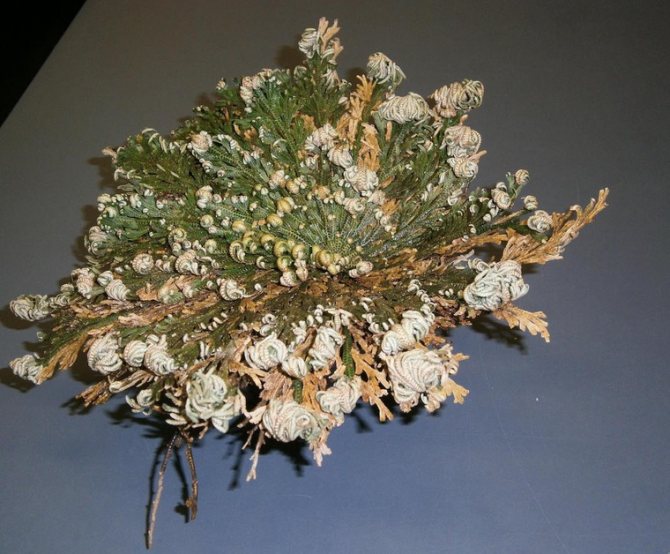

The Jericho rose is a plant that can stay dry for a long time, but as soon as it is lowered into water, it immediately comes to life and blooms. Above: the Jericho rose one day after being plunged into the water.
Thus, the rose has always been a favorite symbol of the Virgin Mary among Christians, and, as if in confirmation of the fact that She also loves roses, the Mother of God during Her appearances was often decorated with roses, or this royal flower accompanied them. Moreover, often these flowers became proof of the truth of Her phenomena. So it was, say, in Guadeloupe, when in December 1531 the Virgin Mary appeared to the Indian Juan Diego (later canonized by the Catholic Church).Then, on a frozen, frost-covered hill near Mexico City, Castilian roses, unknown there until then, grew, and on the cloak in which he brought them to the bishop, the image of the Mother of God was opened - now it is the famous Guadalupe icon - an image, in importance and mystery, comparable only to the Turin Shroud ...


Guadalupe Icon of the Mother of God
The Middle Ages testify very clearly to the connection between the image of a rose and the Virgin Mary. In particular, verses praising the Mother of God, with the repeating refrain "Ave Rosa" - "Hail, Rose" speak about this. Then there was also a custom on the feasts of the Mother of God to distribute roses blessed by a priest, as well as to crown Her statues with wreaths of roses. At the same time, the crowns for the Virgin were woven from white, red and yellow roses - these colors mean joy, suffering and glory of the Mother of God, which, in turn, is associated with Holy Tradition, which says that the Archangel Gabriel once presented the Virgin Mary with three crowns from heaven roses: white, red and gold (yellow).


I must say that in the early Middle Ages a crown of roses was also a symbol of perfection, and in this capacity it was an attribute of chivalry: the heads of knights (especially, of course, winners in duels) were often crowned with roses. For example, here is one common medieval legend that tells of a knight, roses, the Virgin Mary and prayers to Her:
One knight revered the Mother of God so much that he grew roses especially for Her. Every day he cut fifty roses, weaved a wreath from them and crowned the statue of the Mother of God with them, thus expressing his reverence for the Blessed Virgin. Over time, feeling in himself a vocation to a consecrated life, the knight decided to leave for a monastery. The obedience, which the abbot of the monastery determined for him, occupied all his time, and the former knight, and now a monk, no longer had the opportunity to crown the Mother of God with wreaths of roses and was very distressed about this. He told the wise old man about his experiences, and he advised him to give the Mother of God a wreath of 50 prayers "Ave Maria" ("Hail Mary") instead of a wreath of 50 roses every day. The former knight did just that, but still could not be completely comforted. But then one day the abbot sent him to the city for shopping, while giving him a certain amount of money. The path ran through a forest in which robbers lived, who, noticing the monk and realizing that he probably had money with him, decided, seizing a convenient moment, to attack and rob him. Meanwhile, the monk stopped to rest and decided to read his fifty prayers to the Mother of God. The robbers watched him, waiting, and suddenly froze, as if spellbound: a majestic Virgin of unearthly beauty suddenly appeared in front of the monk. While he was praying, the Virgin gathered one at a time the roses that miraculously appeared from his mouth and fell at Her feet, and weaved a wreath out of them. When the monk finished the last prayer, the Virgin finished weaving a wreath, crowned Her head with it and disappeared. The robbers, shocked by what they saw, threw themselves on their knees in front of the monk and began to tearfully ask him for forgiveness for their criminal intentions. When the monk heard from them a story about the appearance of the Virgin (he himself did not see Her), he immediately realized that it was the Virgin Mary Herself, and that prayers were more important to her than roses.


It seems to me that all this is surprisingly reminiscent of the famous poem by A.S. Pushkin "There lived a poor knight in the world." It is possible that the similarity is not accidental, as well as the fact that the knight in Pushkin exclaims "Lumen coelum, sancta Rosa!" ("Light of Heaven, Holy Rose") and puts a rosary around his neck. The legend, it seems to me, sheds light on why a special kind of prayers to the Mother of God, read on the rosary (and the rosary themselves), eventually received the name of the Rosary of the Virgin Mary. But how exactly this happened is a separate story.
Care features
Thanks to the resurrection ability, the Jericho rose can live long enough, but still it should be looked after.The plant must sometimes be allowed to rest, that is, bring it to a dry state so that it curls up into a ball. You can store it rolled up in a closet. Abundant watering of this herb is required so that the soil is constantly moist. An adult plant is best watered through a tray. It is also recommended to constantly spray the leaves of this specimen, and the water is used soft and warm.
Dead leaves will no longer recover, so they should be carefully cut off. When the plant is in a dry state, spider mites may appear. If this happens, then the tick is washed off with soapy water. This plant really does not like a lot of light, so it is better to keep it on a windowsill in a shady room. Be sure to maintain a temperature regime when leaving. Although this specimen is thermophilic, all the same, the temperature must be maintained within the range from +18 to +20 degrees, no more.
| Plant Collectors Databank |
| Photos of plants | Search for plants by name | Selling plants | Collections by area | Photo of flowers |
| Materials of the newspaper "Domashnee Tsvetovodstvo" |
Jericho rose at home
Photo
jericho rose provided for publication by the editors of the newspaper "Home Floriculture"
Rose of jericho |
Rose of jericho |
Rose of jericho |
|
| Seedlings of the jericho rose |
… They gave me a dried ball of thin branches in the form of a ball (15 cm in diameter). Its name is "flower of resurrection". The souvenir was brought from Egypt. They said that the plant is rare, you can hardly find it on sale, and it can be revived ... I was stunned by such a “living” and completely dead gift.
I put it in a vase like dried flowers. I began to remember that somewhere in the books I had already read about him. I did a little search and found out the name - rose of Jericho or anastatica. Her lifestyle is peculiar, like that of a representative of the desert flora. During the dry season, it sheds its leaves, but wakes up to life with the first moisture.
It is called the flower of resurrection, because in her homeland (the desert places of Iran and Morocco), she, throwing off the leaves, turns into a small lump. Desert dry wind drives her across the sands. But now the rainy period begins. Rose of Jericho releases young shoots, leaves, flowers. Seeds are formed.
I didn't really believe it, but I decided to try it. I dipped a ball of twigs into warm water. And she turned into a fluffy bush overnight. I took it out of the water, put it in a plastic bag. Four days later, cotyledon leaves appeared on the branches, they began to germinate, the preserved seeds, the roots reached for moisture. She carefully separated the sprouts, planted them in the ground with sand. Seeds, in brown bolls, cling to all the twigs. The leaves turned green. I will watch.
I thought that the bush was giving roots, it turned out that it was seeds sprouting. Dense translucent brown boxes with two flaps, reminiscent of droplets, were opened. Swollen red seeds (like a radish) appeared, dropped the scales. Then light green round leaves - cotyledons - opened. More and more seeds were sprouting. The tree - a bush was covered with green leaves of cotyledons. The sprouted roots of the yellowish-orange seeds stretched along wet twigs to the water, like white snakes. This wonderful transformation happened in winter (in January), I was in Moscow. Then I returned home to Tambov, and the sprouts moved with me in a plastic bag and in a bowl of water. During the day, the roots grew strongly, sprouts extended. She carefully separated the sprouts with green cotyledons and planted them in a mixture of earth and coarse sand (I arranged a high drainage). She covered the planting with a bag and put it in a warm place. The next day there was sun. Exposed under warm rays. Leaves and stems have turned green noticeably.
January passed. The first landing did not take root. A black leg cut me down. The end of January and the beginning of February were cloudy.
***
On February 8, new seeds sprouted. She separated them again and planted them.Into less fertile land with sand. From the second planting, the most stocky sprouts with good thick roots survived. Two weeks later they gave the third sheet, then the fourth.
Two bushes - twins - roses of Jericho grow in one transparent small glass. They began to bush already 5-6 cm from the ground.
Thin roots thickly entwined the entire earthy ball with white threads and emerged from the drainage hole. There is no tap root. We need to do a transshipment. I was looking forward to whether it would bloom or not. After five months (when it got warmer, it brought it out onto the balcony), the Jericho rose bloomed with tiny white flowers on short peduncles. They look like small butterflies: four petals and six bright yellow stamens. In general, the flowers are inconspicuous, they bloom for several days, new buds appear densely nearby.
The leaves of the rose are light green small, pubescent like a hard felt on both sides.
The weather is cold, rainy now, there is no sun. I would like to take a good photo.
It is interesting how the anastatica manages to grow during the rainy season and bloom profusely before drought and give offspring.
***
By the way, leaving home for a long time, I took out a lush bush from the water. And it again turned into a dry decorative ball of twigs.
Curiosity got the best, and I was looking for material about the rose of Jericho.
I returned home a month later. Again I irrigated the curdled lump with warm water (+ 40 ° C). And he opened up again.
Nina Evtina.
How to care at home: tips and tricks
How to care for a Jericho rose at home, you can learn from special literature. The following are expert tips and general recommendations that will help budding growers cultivate this crop at home. Dry samples of the plant are available at gardening stores. Such specimens, as a rule, have the form of a small ball of gray-brown rolled up inside. This form protects the plant from excessive evaporation so that it can survive long periods without water. To make the bush come to life, you need to put it in a plate and pour boiled water over it. After boiling, water must be cooled to room temperature. Watering with warm water speeds up the process of plant development. Do not forget that only the roots of the plant should be moistened in water. The gradual development of the plant can then be observed in real time. Shoots turn light green and gradually darken.
After two months, the specimen is fully developed, and its rosette reaches 25 centimeters in diameter. After a week, we stop watering. The plant will gradually dry out and curl up into a ball. After 2-3 weeks, it will take the form of a dry sample. We can carry out the process of revitalization and drying several times, each time observing the miraculous resurrection of a flower.
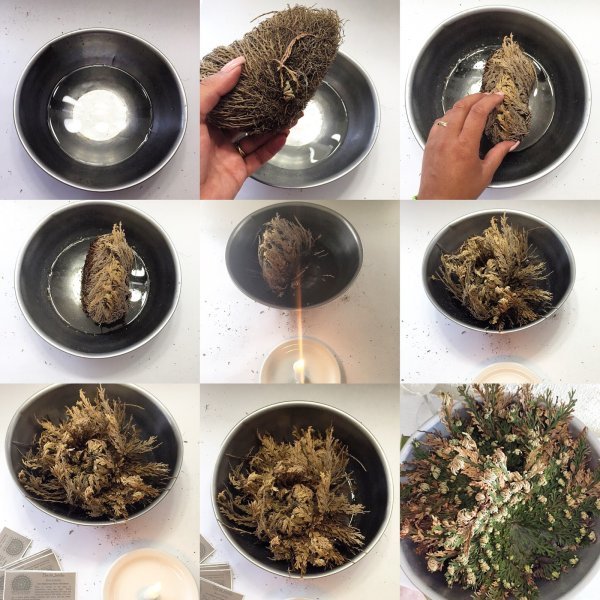

The Jericho rose can remain without water for many months. An interesting fact is that miraculous revival occurs only in dead plants. The bush is dead and there is no point in planting it in a garden or pot.
History and description of the Jericho rose
Botanically, an annual culture from the Cabbage family is known as anastatica of Jericho. From ancient Greek, anastatica means "resurrected again." The plant was first mentioned in the Middle Ages, when, during one of the Crusades in the Egyptian desert, the knights discovered this amazing flower.
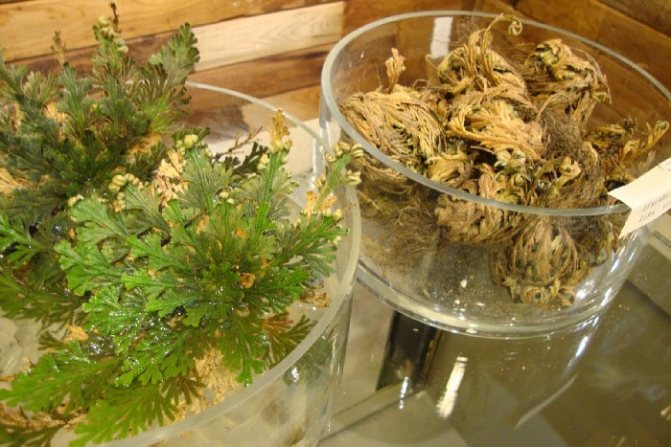

Jericho rose
– mysterious desert flower
The Jericho rose is often confused with selaginella or asteriscus. To understand the main differences, here is a brief description of the anastatic:
- the size of the plant does not exceed 15 cm;
- the leaves are small, gray-green;
- inflorescences are tiny, snow-white;
- the fruits are pod-shaped, twisted.
Distribution area
The natural habitat of the rose of Jericho is the hot deserts in northern Africa and western Asia. Anastatica grows in Iran, Israel, Morocco. The flower is most popular in Egypt.Here it is sold to tourists as an unusual curiosity that comes to life literally before our eyes upon contact with moisture.
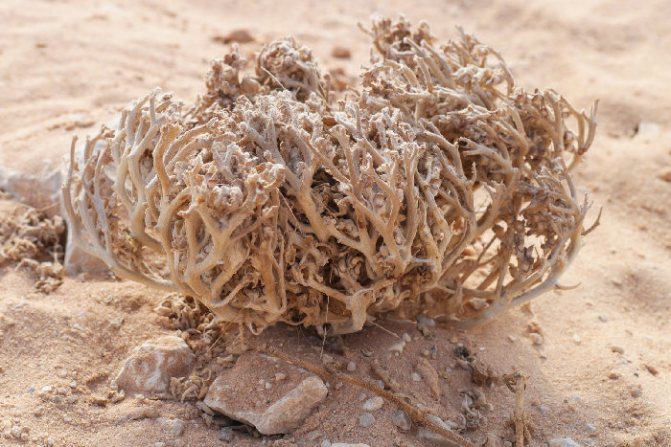

Homeland of the rose of Jericho - North Africa
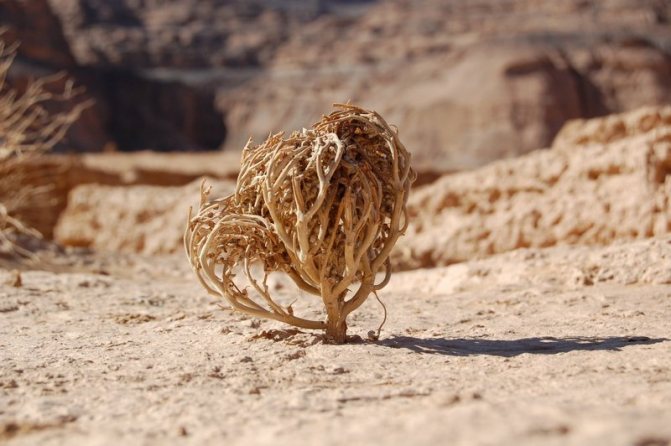

Anastatica grows in Iran
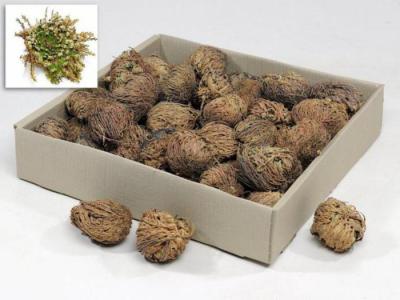

In Egypt, a flower is sold to tourists
The life cycle of a culture
The first shoots appear with the onset of spring, when the dry period has not yet begun. The plant is actively gaining growth, throwing flowers, and later bears fruit. With the onset of drought, the leaves curl up, forming a dry small ball. Taking off from the soil, he, driven by the wind, begins his journey through the desert. Having found a source of moisture, the anastatica revives again and sheds seeds that can lie in the sand for several years.
The benefits and uses of the plant
A nondescript-looking Jericho rose can benefit its owner. So, the following qualities are inherent in it:
- protection against moths and other harmful insects;
- absorption of unpleasant odors;
- air purification;
- room decoration;
- improved sleep.
The symbolism and dignity of the rose
Silaginella scaly symbol of centenarians and resurrection
- This is a long-lived flower, therefore it can be inherited as a symbol of the genus.
- It is customary to give it on the day of the Resurrection of the Lord, as a reminder that after death the resurrection of the soul will come.
- In a dried form, a ball is given to each other by lovers, placing it inside a ring. When the flower opens, the rings are taken out.
- By placing the rose inside the cabinet, it will scare away moths.
- The bush thinns the light aroma of meadow grasses, therefore it is used as a natural air freshener.
- Disinfects the air from harmful microorganisms, absorbs tobacco smoke.
- The mechanism of opening and closing branches can be interesting for children.
Additional Information! In the story "The Rose of Jericho" I. Bunin tells about a legend, which says that the name of the flower was given by the Monk Sava when he was in the Judean wilderness.
The bush does not come to life in the literal sense of the word, dried shoots do not turn green again, as flower catalogs sometimes promise. When in a humid environment, they open, and the seeds remaining inside begin to turn green. But even the very process of opening and closing branches is interesting to observe.
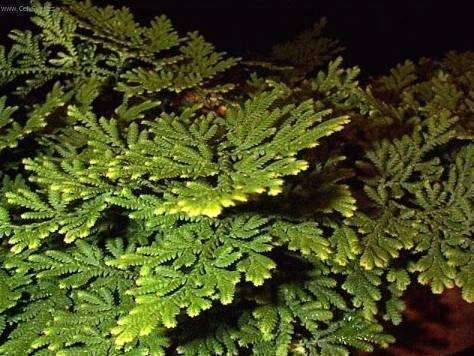

The Jericho rose or Selaginella comes from the Selaginella family. These flowers belong to the most ancient genus of composes, which means that they do not grow up, but spread along the ground. Before you start this plant, you should carefully study the conditions of detention. This flower grows in subtropical and tropical zones, and, therefore, it needs high humidity and constant warmth. The uniqueness of this flower is that it can live without water for a long amount of time, more than 90 years. Another feature of the Jericho rose is its ability to resurrect. That is, when a drought sets in in the desert, this flower begins to dry out, rolling its leaves into a ball, like a cabbage. The seeds are carefully preserved inside this ball. After that, he rolls across the desert in the squeak of water. As soon as water is found, the rose will open its ball and begin to grow as if nothing had happened. And this can happen many times. This is due to the content of oils in the sap of the flower.
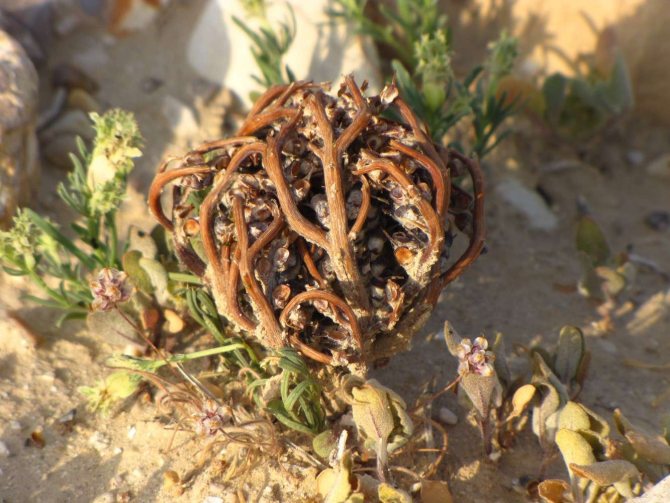

Flower legends
The biblical version of the appearance of this flower claims that Mary discovered the unusual plant on her way to Egypt. She blessed him for immortality. Therefore, it is sometimes called "the hand of Mary".
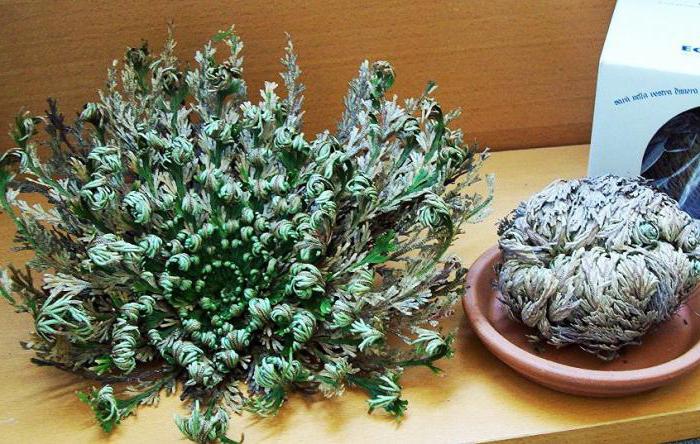

The second legend is described in the famous story "The Rose of Jericho" by Ivan Bunin. It says that the name of the herbaceous plant was given by the Monk Sava, settling in the Judean desert.
How can a flower be propagated
The described plant has nothing to do with a garden rose, and it is impossible to propagate it at home.
The unique flower is long-lived.After contact with water, when the shoots open, a new green mass begins to grow, on which seed pods should form after flowering.
But if in the wild a representative of the flora travels like a tumbleweed and throws out the seed in a wet place, then at home this does not happen.
Spread
The rose of Jericho - a plant that is better known as tumbleweed, “lives” in the deserts of Western Asia, from Syria to Arabia and from Egypt to Morocco. It is also found in Central Asia.
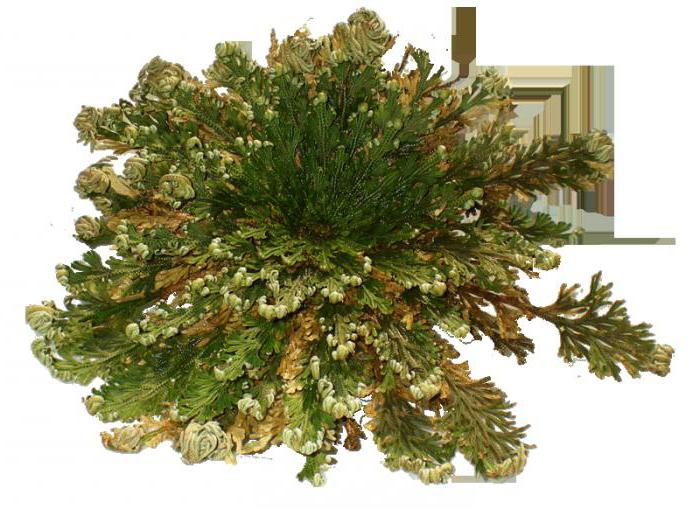

There are several types of the rose of Jericho, so it is important to know their differences before deciding what kind of care a particular plant needs.
The most common type is the Martens rose. It has erect stems that can reach a length of thirty centimeters, but gradually they become lodging. Its branches slightly resemble ferns, but the tips of the leaves are silvery-white in color.
Selaginella scaly has stems that do not grow more than ten centimeters in length. If the humidity in the room is insufficient, they curl into a ball, but as soon as the plant is watered, it immediately comes to life and scatters the leaves.
Preservation of the Jericho rose from pests and diseases
Despite the fact that the plant does not need any additional care, it can become infected with the fungus in a dormant state. Therefore, to avoid this, it should be treated with a fungicide solution from time to time. Treatment must be carried out immediately when mold appears.
It is important to constantly check the inflorescences for the presence of mold, otherwise the plant will disappear. This flower is not intended for outdoor cultivation, as our climatic conditions are not suitable for it. But the Jericho rose can be grown as indoor. It will serve as a wonderful decor for stone gardens. It is very simple to care for, and even a beginner in floriculture can keep it.

